CEHD Research & Innovation Day
Research and Innovation Day 2024 was held on March 21, 2024.

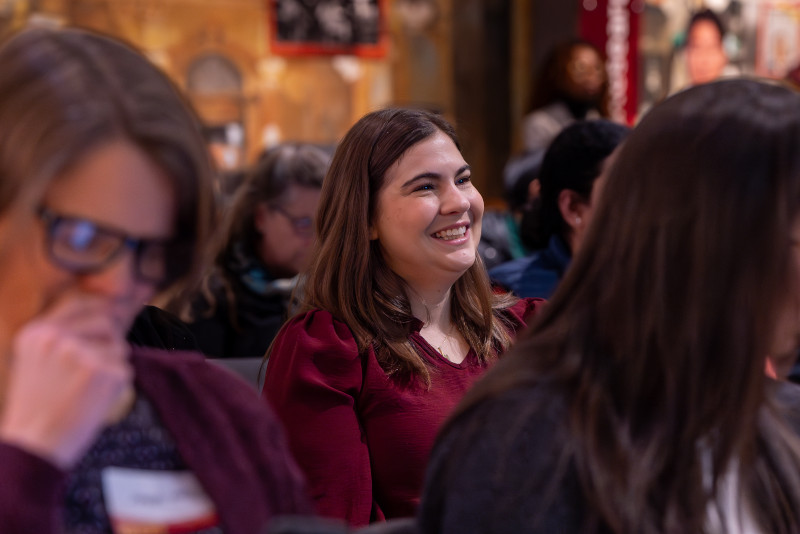

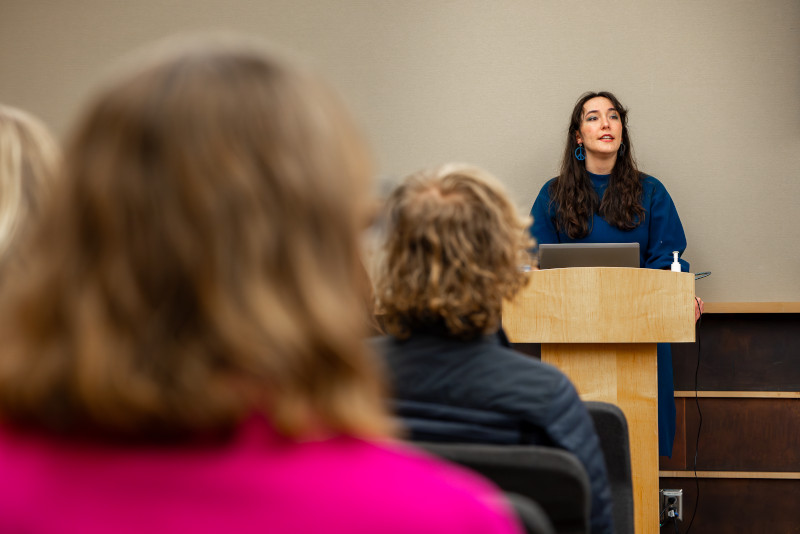

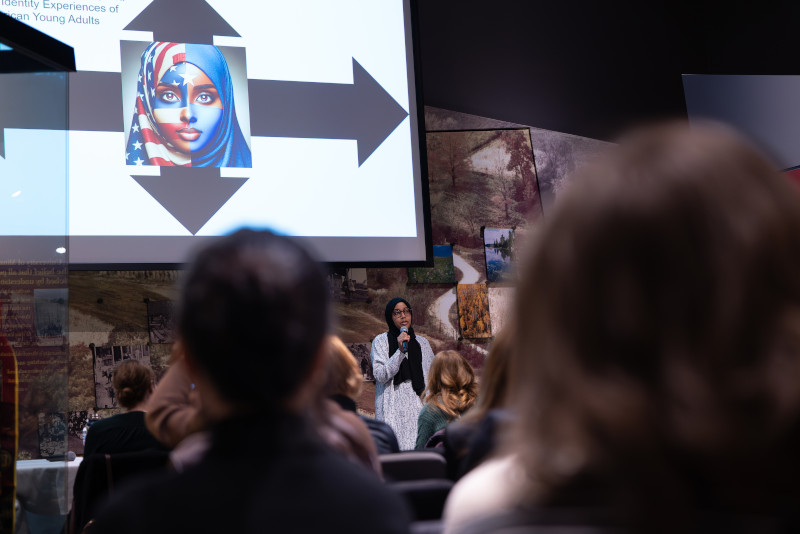
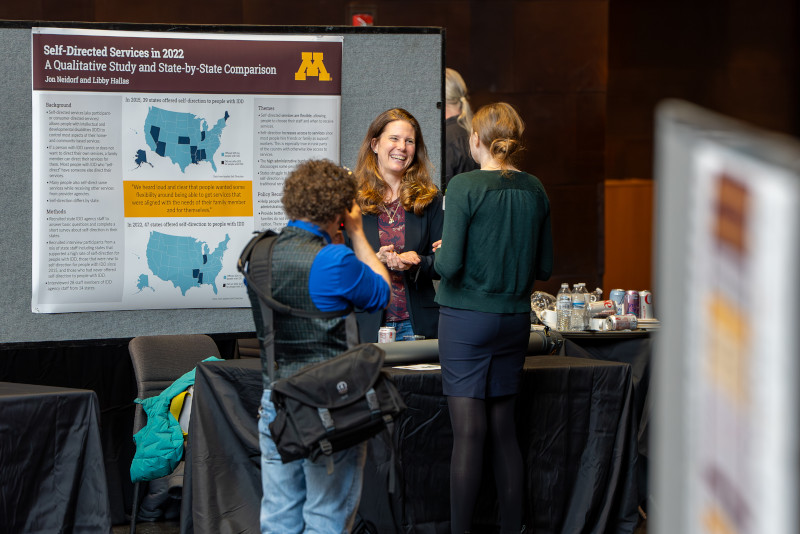

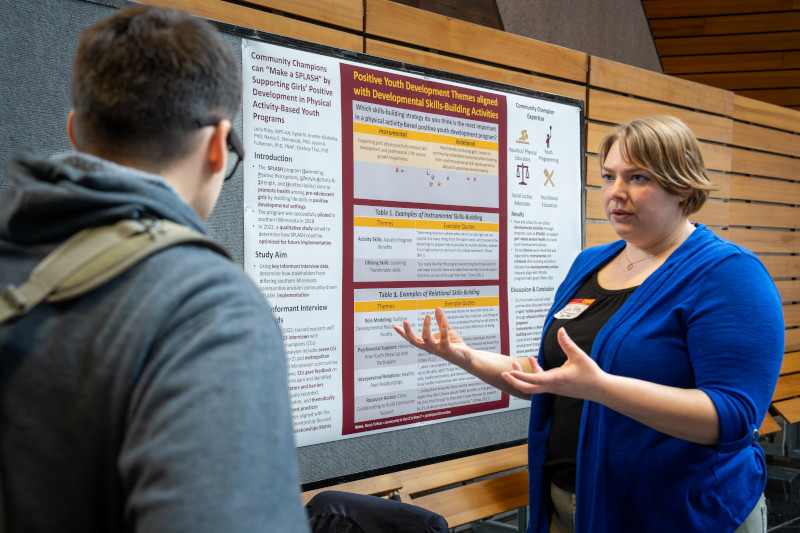


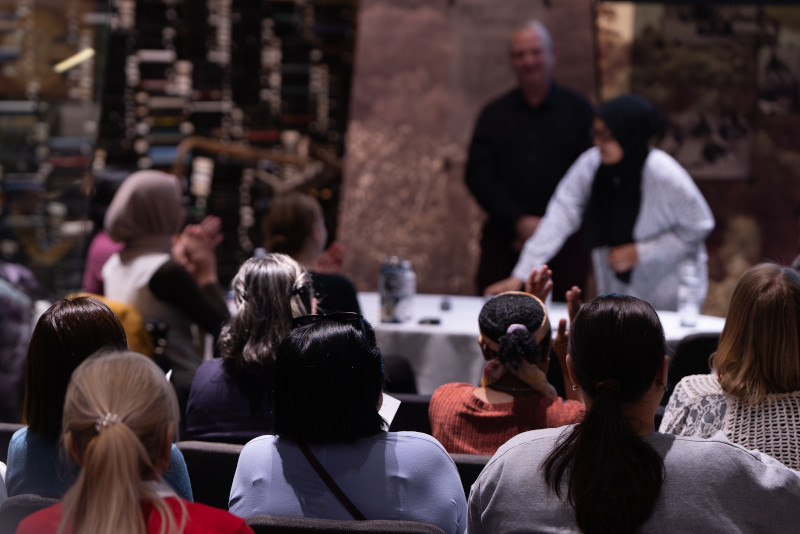
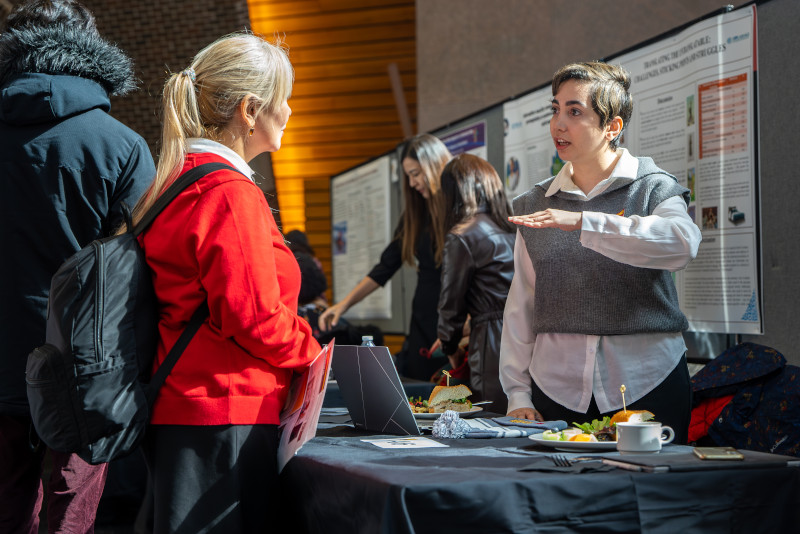

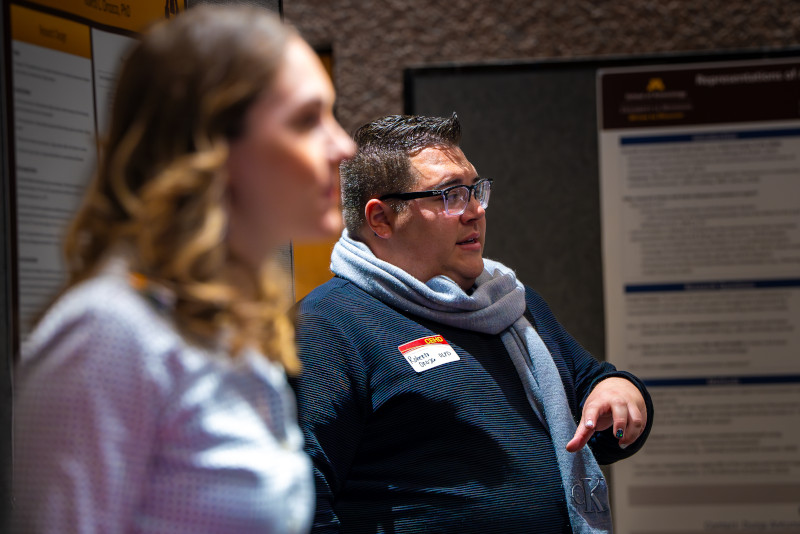



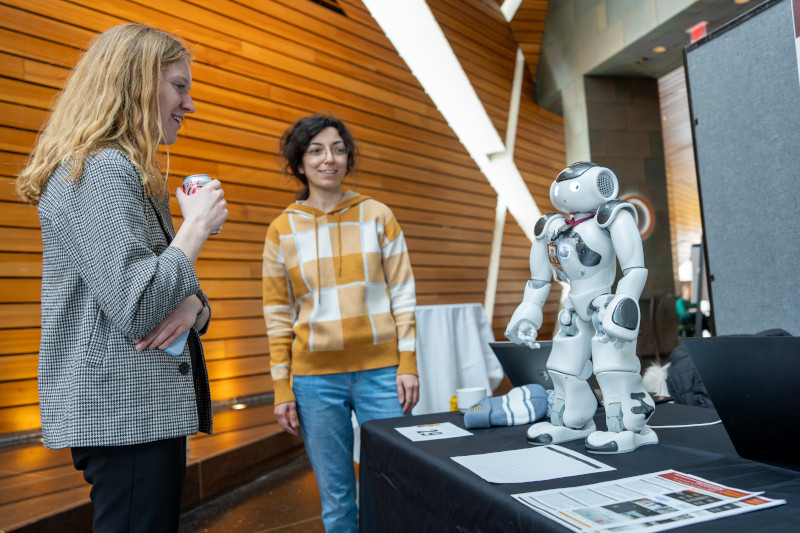
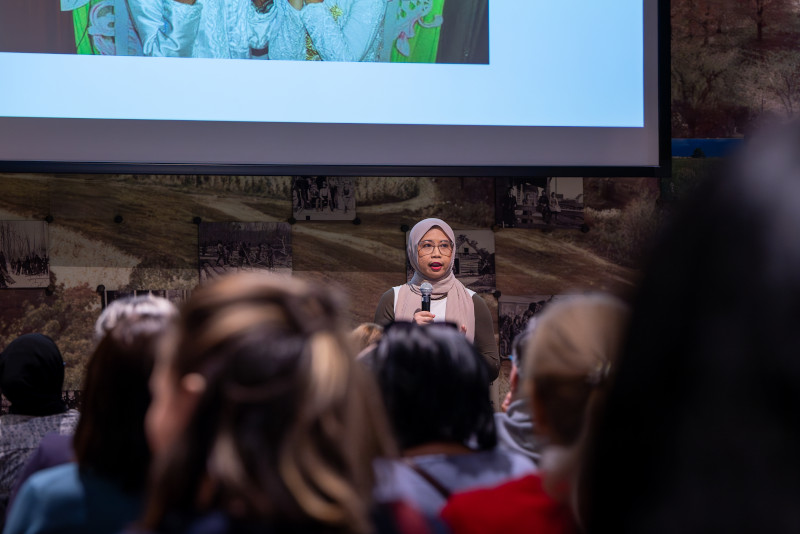

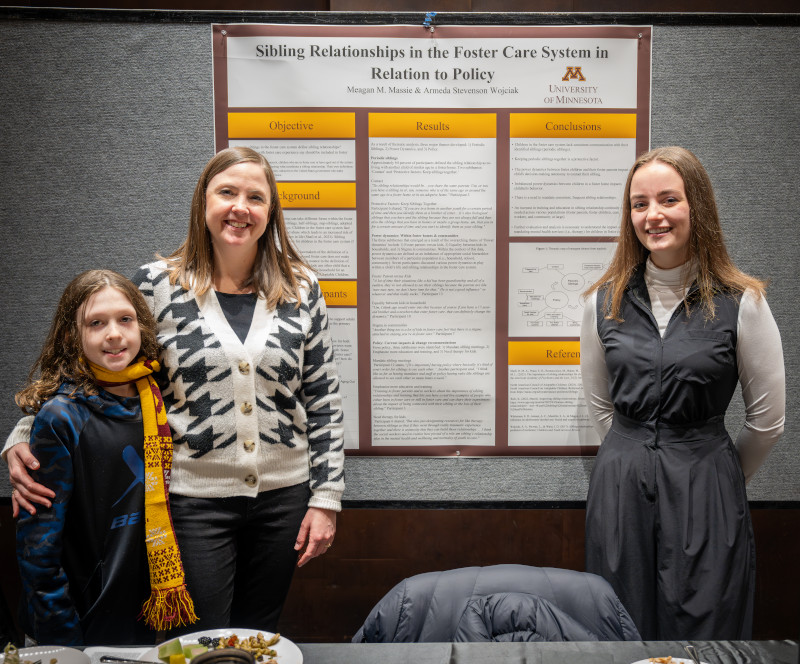



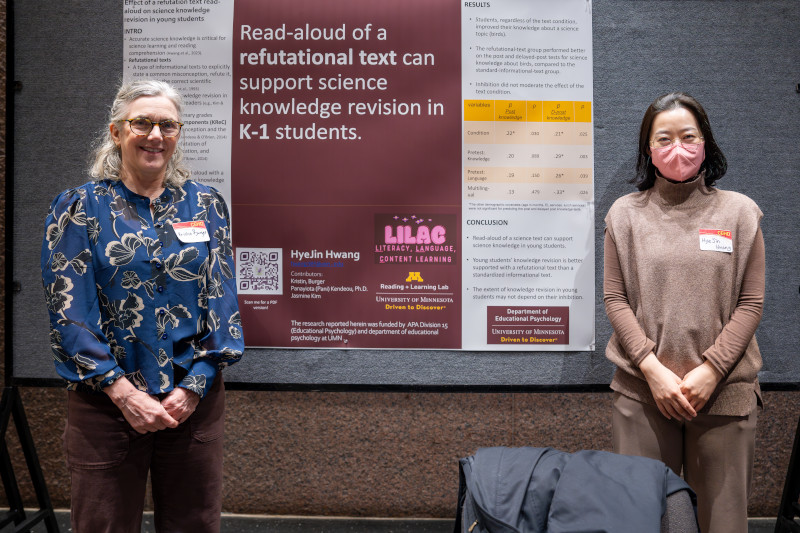
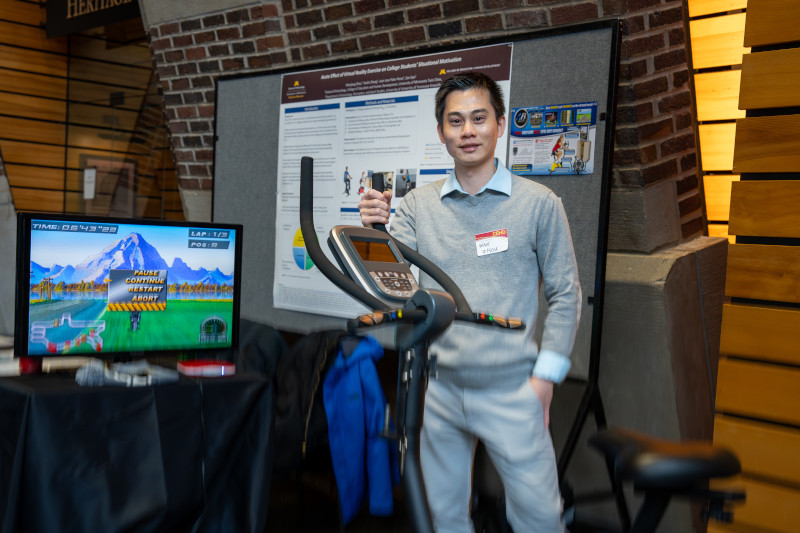
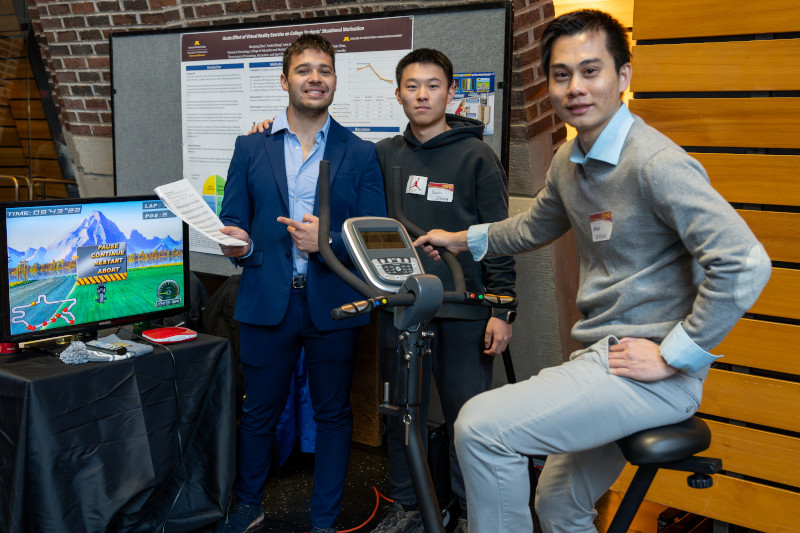




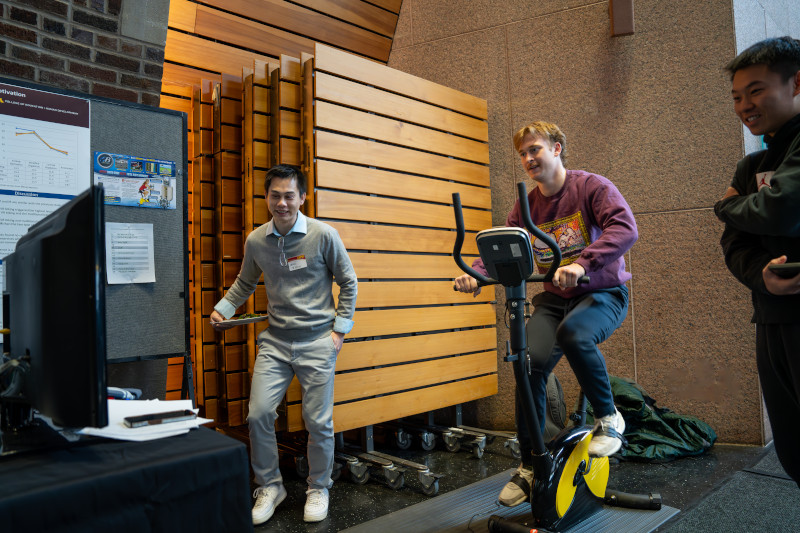

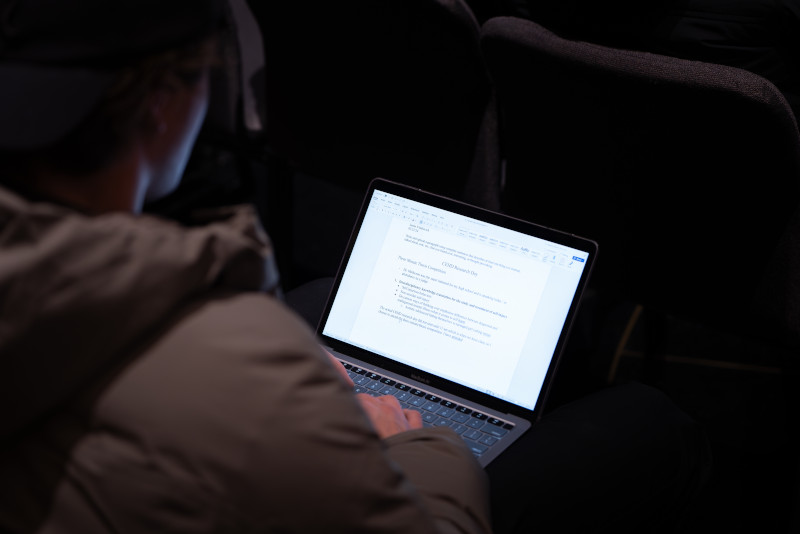

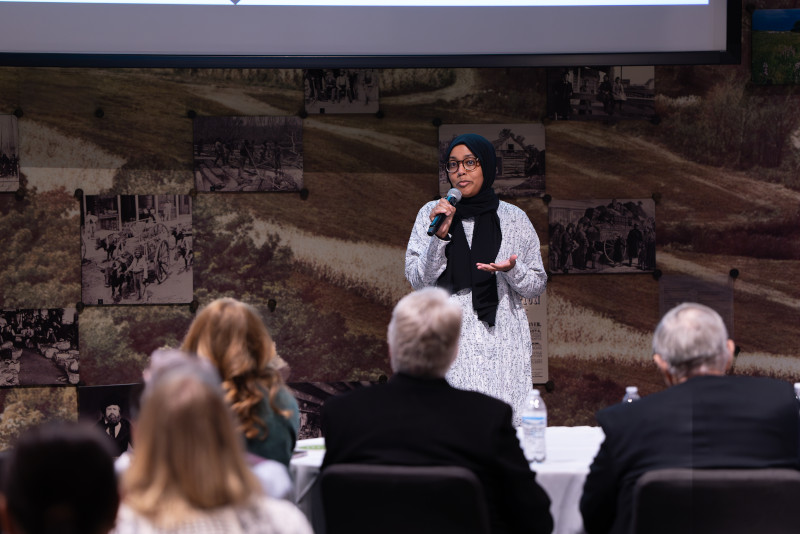
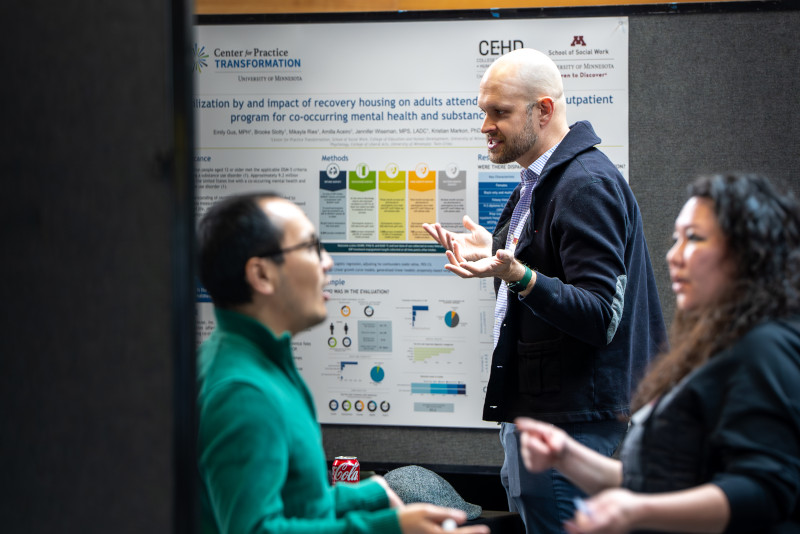

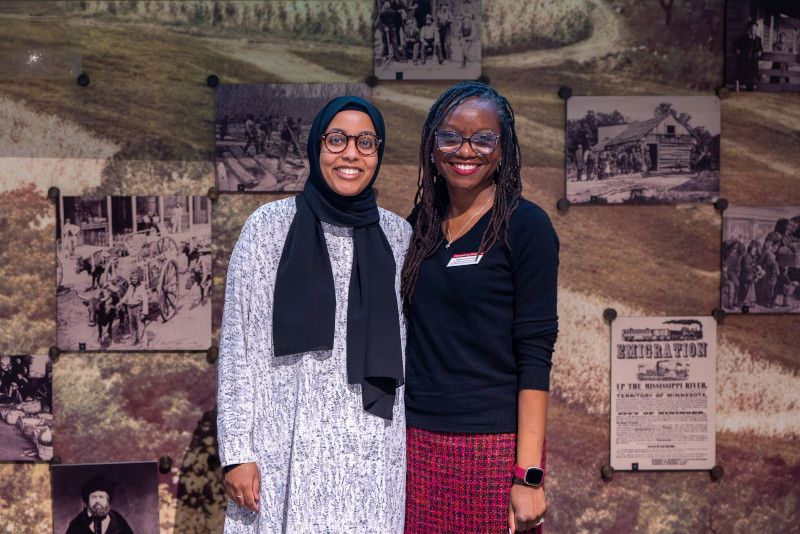
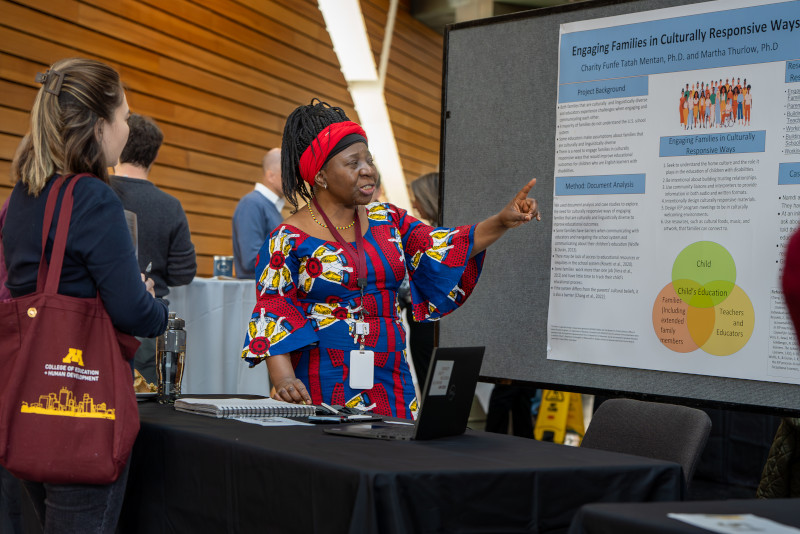
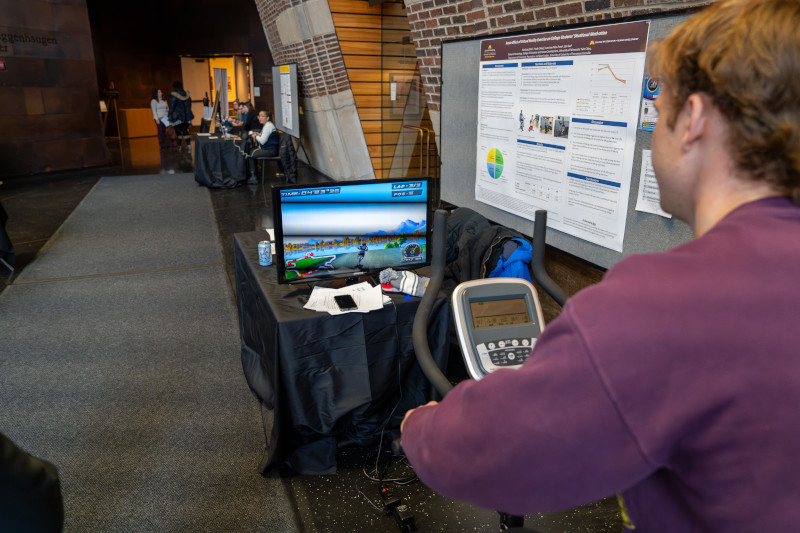

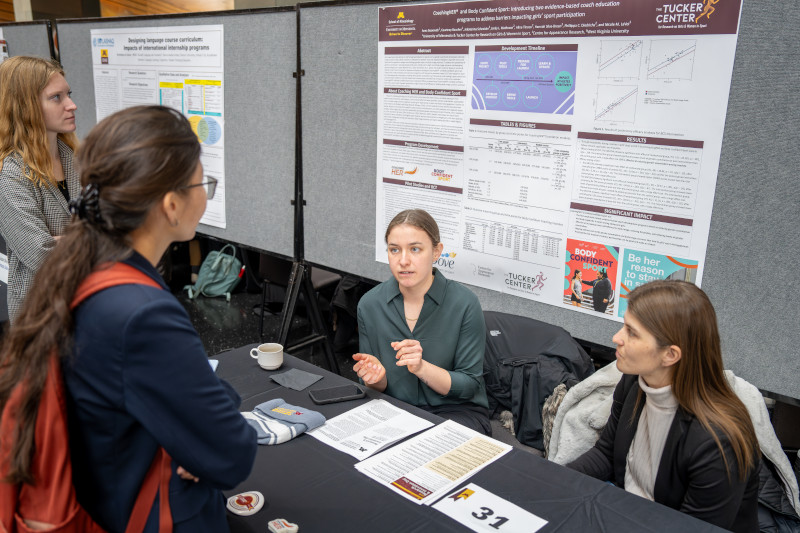
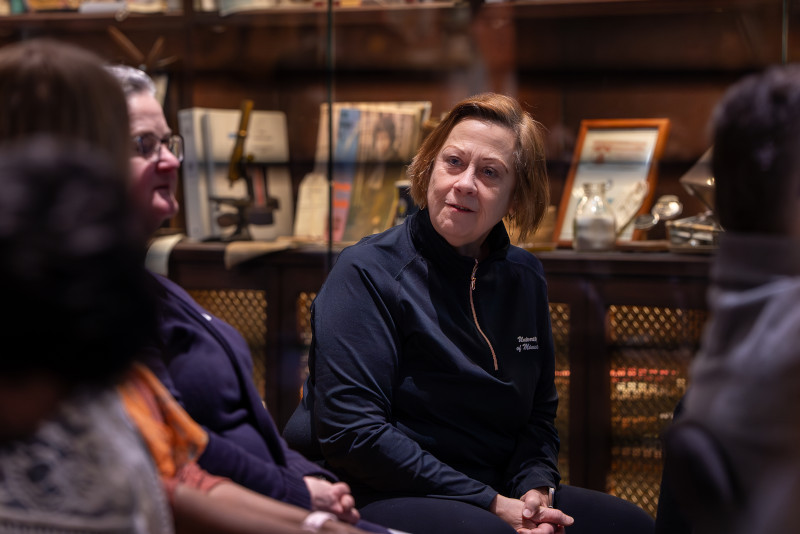
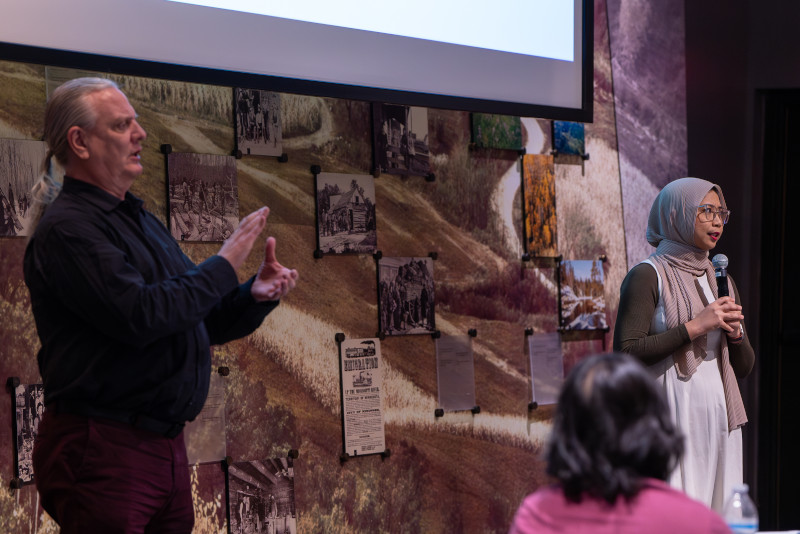

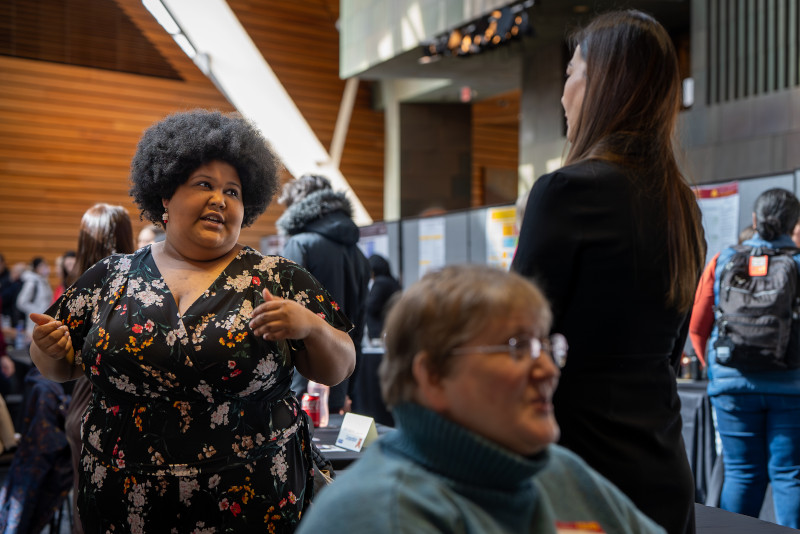
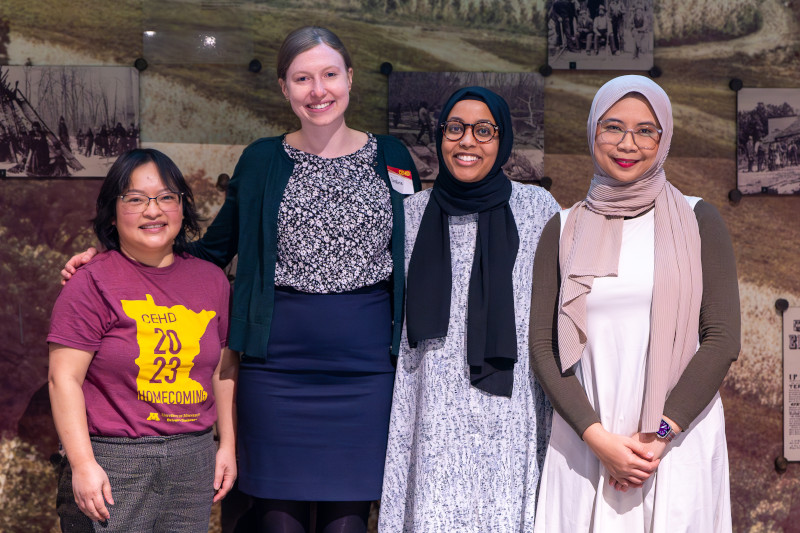


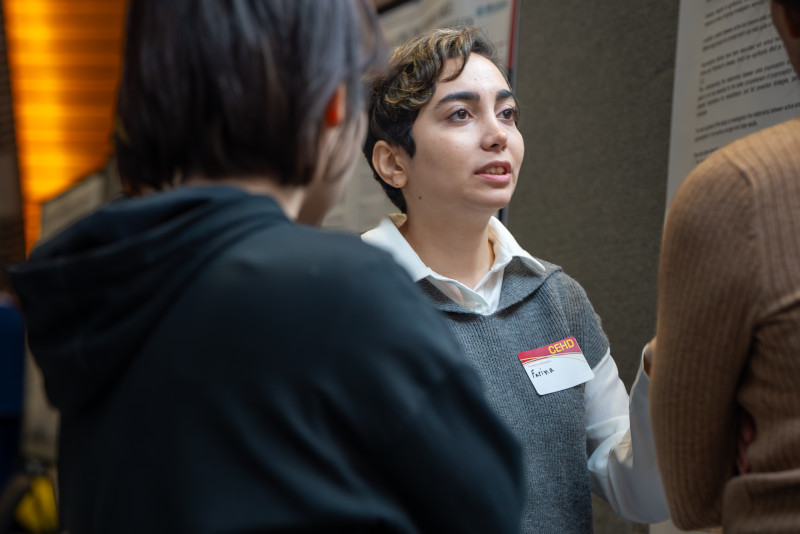
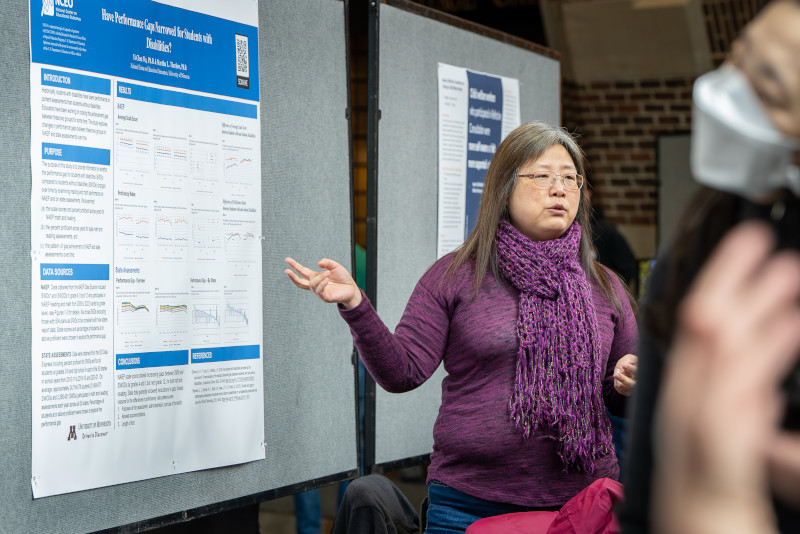
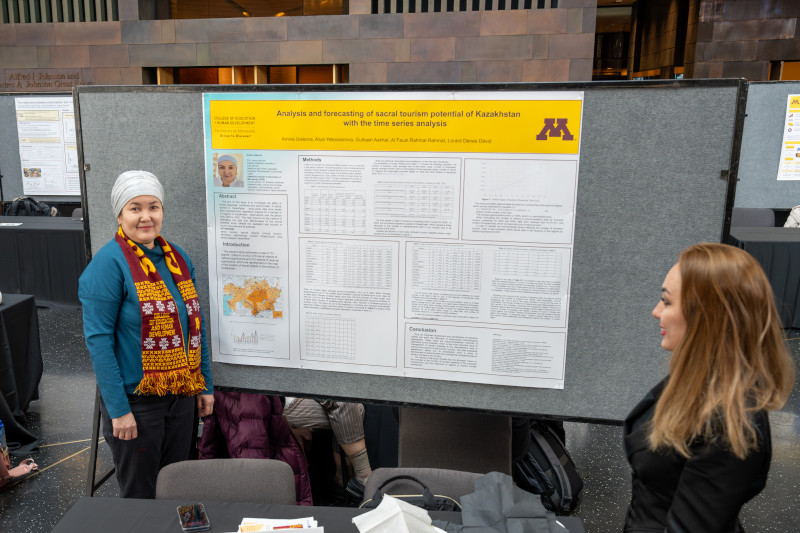

CEHD Research Day 2024 was held on March 21 in Memorial Hall,
McNamara Alumni Center.
Photos by Jairus Davis.
View posters from Research Day 2024
If available, click the poster title to view the poster PDF
Research Day posters from previous years are available in the UMN Data Conservancy
Actigraphy- Derived Sleep Health, Stability, and Associations with Clinical Features in Rett Syndrome
Author(s): Alyssa Merbler, Chantel Burkitt, Frank Symons, and Breanne Byiers
Rett syndrome is a severe neurodevelopmental disorder primarily affecting females, with consistently documented sleep problems. Actigraphy uses a watch-like device to measure movement that can determine sleep/wake times and circadian rhythm stability. Stability has yet to be examined in Rett, thus the purpose of this study was to use actigraphy to investigate sleep health, stability, and associations with clinical features and quality of life (QOL). Thirty-seven girls and women with Rett wore a sleep watch for 14 days. We calculated summary sleep variables, such as wake time after sleep onset (WASO), and circadian stability including the consistency of the circadian rhythm of activity across days (IS) and the ratio of day vs. night movement (RA). This sample had lower sleep efficiency (% of time asleep when in bed) and higher WASO than is recommended, indicating poorer sleep health and a need for assessment and intervention. WASO and fragmentation of sleep across the night were negatively related to physical quality of life. There were no associations with clinical severity. Mean IS and RA were within the range of typically-developing female referent values by age group. These measures of sleep health present clinical trial target opportunities and warrant further study.
Impact of Reflective Consultation and Training on Child Welfare Workers
Author(s): Alyssa Meuwissen and Meredith Reese
Given the high rates of stress in child welfare jobs, it is crucial to provide supports to this workforce that promote resilience. Reflective consultation (RC) is a model used in many early childhood sectors to support the processing of difficult emotions and provide a space for reflection. A model of Reflective Consultation + Training (RC+T) was developed specifically to support and build skills in reflection for child welfare workers. We piloted the model for about 1.5 years and evaluated its impact on the participants in one county agency unit. From pre- to post, participants showed increased reflection around self-knowledge and self-regulation, measured by coding speech samples. Their feedback showed they also felt that the practice built relational support that helped them cope with work stress.
Author(s): Amber Reilly and Dr. Savana Bak
The study employed qualitative methods, specifically 1:1 interviews, to investigate the adaptations that behavior analysts serving Somali families with a family member with autism make when conducting family training and education. To be included in the interviews, the individual had to have at least one year of experience supporting Somali families with a member with autism in an applied behavior analysis related professional field (e.g., Board Certified Behavior Analysts, speech language therapists). More specifically, the research question was “what considerations are necessary to adapt autism-specific family interventions for Somali families?” The questions for the topic guide were developed based on the Ecological Validity Model (EVM; Bernal et al., 1995) and further modified based on Barnett and colleagues’ (2019) study of therapists’ adaptation of children’s evidence-based practices. The semi-structured 1:1 interviews lasted approximately 60 minutes, and thematic analysis (Braun and Clarke, 2005) was used to identify themes. After analyzing the preliminary data, themes include 1) using appropriate language and styles of communication; 2) incorporating ideals related to religion; 3) building trust through including feedback and providing relevant examples; and 4) tailoring the contextual elements (e.g., setting, length) and methods (e.g., prompting, role-play). Implications, limitations, and future directions will be addressed.
Author(s): Amina Uaisova, Aliya Yeleussinova, Gulnash Askhat, Al Fauzi Rahmat Rahmat, and Lóránt Dénes Dávid
The aim of this study is to investigate the effect of tourist resources, conditions and opportunities of sacral tourism in Kazakhstan using panel data (time series and cross-sectional) regression analysis for a sample of 14 regions of Kazakhstan observations over the period from 2004 to 2022. The main focus is on the method of estimating the size and effectiveness of the tourist potential, which reflects the realization and volume of tourist resources and its potential.
Happiness with Recovery from Alcohol and Substance Use Disorders Predicts both Abstinence and Treatment Retention
Author(s): Amy R. Krentzman, Sarah E. Zemore, and Elizabeth A. Bowen
"Although research has primarily focused on the role of indicators of poor functioning in treatment outcomes for alcohol and other substance use disorders (SUDs), a growing body of positive psychology research explores the importance of indicators of wellbeing for SUD recovery. We conducted a secondary analysis of data from an intervention study to clarify the association between wellbeing indicators and treatment outcomes. We recruited participants (N=81) from SUD treatment programs. We used baseline survey data to examine the association between wellbeing indicators and abstinence (yes/no) and treatment retention (leaving on good terms/leaving for other reasons). Logistic regression models examined the relationship wellbeing indicators and treatment outcomes. Serenity (OR=1.386) and happiness with recovery (OR=1.625) were associated with abstinence; and positive affect (OR=1.121), flourishing (OR=1.119), and happiness with recovery (OR=1.501) were associated with leaving treatment on good terms, controlling for covariates (p<.05). People who are happy with recovery are more likely to remain sober and leave treatment on good terms. “Overall, I am happy with my recovery” is a simple item that shows promise for measuring wellbeing in recovery and a potential target for intervention. Future studies should use larger samples and study these relationships in subpopulations of people in recovery."
Author(s): Andrea Castillo, Anne Larson, PhD, CCC-SLP; Jennifer Hall-Lande, PhD, and Jennifer Meraz Barrera
This project evaluated Latine families’ experiences accessing, participating in, and transitioning from, EI. Critical perspectives and suggestions derived from family stories will be shared to inform future programming, training, and reciprocal community engagement aimed at equitable systems change to support young children with delays/disabilities and their families.
Physical inactivity following volumetric muscle loss results in a divergence between whole-body and cellular metabolic dysfunction
Author(s): Angela Bruzina, Christiana Raymond-Pope, Kevin Murray, Thomas Lillquist, Katelyn Castelli, Shefali Bijwadia, Jarrod Call, and Sarah Greising
Volumetric muscle loss (VML) refers to significant muscle loss due to injury or surgery, and is characterized by metabolic dysfunction. Following VML, prolonged bedrest and life-long disability may worsen metabolic dysfunction. This work aimed to elucidate the impact of VML and physical inactivity on whole-body, cellular, and metabolomic environment of the remaining uninjured muscle. Adult male mice (n=40) underwent unilateral VML to the posterior hindlimb compartment or served as age-matched injury naïve controls, then were randomized to standard or restricted activity cages for 8-wks. Inactivity following VML resulted in ~7% decrease in metabolic rate compared to VML alone, while 24-hour respiratory exchange ratio (RER) increased by ~5% with inactivity. Carbohydrate oxidation was ~23% higher with injury and inactivity, but lipid oxidation remained unchanged. Regardless of inactivity, whole-body glucose tolerance was higher following VML compared to injury naïve controls. Protein expression related to muscle metabolism was mostly unaffected by injury or inactivity. Injury decreased mitochondrial enzymatic activity related to fatty acid oxidation capacity. Inactivity alone did not significantly alter the metabolome. Overall, while inactivity did not exacerbate whole-body metabolic dysfunction beyond VML alone, it led to functional changes in fatty acid metabolism in VML-injured muscles. Understanding these mechanisms could help mitigate metabolic diseases associated with physical inactivity following VML.
CoachingHER® and Body Confident Sport: Introducing two evidence-based coach education programs to address barriers impacting girls’ sport participation
Author(s): Anna Goorevich, Courtney Boucher, Jekaterina Schneider, Emily L. Matheson, Aline Tinoco, Hannah Silva-Breen, Phillippa C. Diedrichs, and Nicole M. LaVoi
Girls experience many barriers in and through participation in sports such as gender essentialist stereotypes and biases and body image concerns (LaVoi, 2018). Coaches are influential in athletes’ lives and important mediators of gender norms, but often feel ill-prepared to navigate and challenge gender biases and body image pressures. To address the prevalence of gender essentialism in coaching (Goorevich & LaVoi, 2024) and the high risk of body image concerns and disordered eating amongst girls in sport (Marashi et al., 2023; Silva-Breen et al., 2022), the Tucker Center for Research on Girls & Women in Sport and the Centre for Appearance Research developed CoachingHER® and Body Confident Sport; two industry-first, evidence-based coach education programs, with the goal to positively impact 11-17 year old girls in sport by challenging gender stereotypes, breaking down gender essentialist coach discourses, and creating a sport culture that promotes body confidence. Two pilot studies and a randomized controlled trial of coaches of girls who completed CoachingHER® and Body Confident Sport were conducted. Efficacy analyses found CoachingHER® and Body Confident Sport led to lower levels of gender essentialism, higher levels of self-efficacy toward body image, and lower levels of fat phobia amongst the coaches.
Responder or Non-responder? Examining Responsivity to a School-Based Anxiety Intervention
Author(s): Faith Miller, Anna Li, MA, Emma Murphy, MA, and Abigail Decipeda
Anxiety is a significant mental health issue widely impacting children and adolescents that requires intervention in order to mitigate negative outcomes and lifelong impacts. This poster presentation describes a research project designed to compare different anxiety measures in the context of a school-based anxiety intervention. The current landscape of youth anxiety measures are primarily diagnostic in nature, aligned to DSM symptoms, were not designed for progress monitoring purposes, and have limited treatment utility (Becker-Haimes et al., 2020). Often, the effectiveness of interventions are determined through commercially available, validated, pre/post-test assessments. However, such rating scales often ask respondents to reflect on their symptoms over a prolonged period of time (e.g., Over the past 3 months, how often have you…?). This measurement approach is problematic when used in school settings, where the duration of interventions are relatively brief (e.g. 6-8 weeks). Further, such assessments are expensive, and schools face dwindling budgets and resources. Finally, pre/post-test assessments do little to inform real-time treatment decisions. Consequently, efforts have been undertaken to develop Direct Behavior Ratings – Anxiety (DBR-A) in an effort to expand the landscape of available progress monitoring tools that are efficient, technically sound, and can directly inform intervention efforts.
Exploring the Landscape of School Mental Health in Minnesota
Author(s): Annie Goerdt, Mengchen Su, and Meg Olson
The prevalence of mental health needs for children and adolescents has expanded significantly in the wake of the COVID-19 pandemic. In Minnesota, approximately 29% of students report having long-term mental health needs. A large proportion of those needs go unmet, with only half of those diagnosed with a mental health condition subsequently receiving mental health services. Despite this need, we have little to no information on the availability, accessibility, and effectiveness of care related to school mental health in Minnesota. This proposal will describe an active, multi-phase project examining the landscape of school mental health in Minnesota. We will also present preliminary findings for the first phase of the project, which utilizes existing data (e.g., prior survey data, staffing reports) to identify gaps in our understanding of school mental health in Minnesota.
From Access to Achievement: Engaging and Empowering Students on the Path to Research and Graduate School
Author(s): Anthony Albecker and Kayla Cory
The Gopher Grad Initiative (GGI), created by CEHD’s TRIO McNair Scholars Program, is a coalition of professionals and University resources. GGI conducts workshops tailored to the needs of first-generation, Pell-eligible, and traditionally overlooked students, aiming to expose them to research engagement and graduate school opportunities. GGI transforms structures and systems to engage students in research and prepare them for graduate school. This initiative reimagines higher education partnerships to demystify the graduate school process, dismantle hidden curricula, and support students' post-baccalaureate pursuits. GGI is accessible to college students across the state participating in TRIO-like programs committed to maintaining an open pipeline to undergraduate research opportunities and graduate school. This poster will share the unique challenges and opportunities GGI has addressed over the past four years, along with a projected path for the future.
Author(s): Bonnie Horgos, MSW, LGSW
Hungary has one of the highest rates of alcohol use disorder (AUD) in the world, yet the literature primarily focuses on alcohol consumption in Hungarian men. Furthermore, AUD is continuing to rise in women globally. Given the history of alcohol use in Hungary and growing levels of AUD in women, AUD in Hungarian women may be a latent issue that must be better understood. Therefore, this systematic review aims to assess alcohol consumption levels and associated risk factors for AUD among Hungarian women. A systematic review yielded 526 articles, with 17 selected for full-text review; 10 articles were excluded due to lack of rigor or falling outside of the scope. The remaining seven articles demonstrated moderate evidence that Hungarian women consume less alcohol than Hungarian men. However, the studies showed that women with co-occurring mental health disorders and a history of trauma may experience higher rates of AUD. Future research should focus on changing patterns of alcohol consumption in Hungarian women, particularly those with co-occurring mental health disorders and a history of trauma.
Synchrony and Flexibility in Parent-Child Interactions and Relations with Restricted and Repetitive Behavior
Author(s): Breanne Byiers, Jaclyn Gunderson, Caroline Roberts, Adele Dimian, and Frank Symons
Parent-child interactions are critical for child development. Dynamic systems theory (DST) posits that structural features, such as flexibility, are important predictors of resilience. Such dynamic are influenced by the characteristics of both members of the dyad, as well as environmental/contextual factors. Although it has been suggested that restricted and repetitive behaviors (RRBs) may influence how parents interact with their children developmental disabilities (DD),no studies have yet investigated associations between RRBs and dyadic flexibility among dyads with young children with DD. Forty-eight caregivers of children aged 1-12 years participated in the study. Unstructured free play sessions were coded using behavioral definitions categorized as negative, neutral, or positive based on previous research. Two variables were extracted: Flexibility, or the rate of dyadic behavioral transitions; Synchrony, or the proportion of observed time in which both members of the dyad were engaged in positive behaviors. Restricted and repetitive behaviors were evaluated using the Repetitive Behavior Scale – Revised. Synchrony and flexibility in combination were predictive in all models, but the specific patterns varied by RRB type and by autism diagnostic status. Additional studies in larger samples are needed to replicate these findings, particularly considering the wide range of ages and ability levels.
"Achievement goal theory-based psychological skills training session buffers youth athletes’ psychophysiological responses to performance stress."
Author(s): " Candace Hogue"
The purpose of this investigation was to examine whether an achievement goal theory-based psychological skills training (PST) session would elicit protective responses to performance stress in youth athletes. High school teams (N = 72 athletes, Mage = 16.08) were randomly assigned to either an experimental group that took part in a PST session prior to stress exposure or a control group. During the PST session athletes were encouraged to support one another and focus on their skill mastery. Cortisol and dehydroepiandrosterone (DHEA) were measured prior to (t = - 50 and 0 min) and following (t = +30, +45, +60 min) stress exposure. Psychological stress and motivational responses were measured after. The PST session helped buffer maladaptive responses to performance stress, with no changes in cortisol and DHEA levels in the PST group. They also reported greater social and performance self-esteem compared to the control group. Athletes in the control group responded with a spike in salivary cortisol and DHEA and reported greater psychosocial stress experiences than the athletes in the PST group. There was a pattern of male athletes responding more adaptively to performance stress than female athletes. Potential explanations and ways to prevent such discrepancies are discussed.
Mental Health Ambassador Program: A new way to empower and support community leaders advocating for youth mental health
Author(s): Cante Nakanishi, Sophie Frank, Briana Joseph, Yunqi He, Eric Pothen, and Lindsey Weiler
According to the CDC (2023), many youth in the United States experience mental health challenges, with estimates as high as 44%. In Minnesota, 29% of students reported long-term mental health problems, continuing an upward trend beginning several years ago (MN Student Survey, 2023). Mental health care systems could greatly benefit from trained community members who can provide low-intensity mental health support and referrals to appropriate services as part of a stepped care approach to mental health. To address this need and advocate for youth mental health, MENTOR Minnesota and the University of Minnesota partnered to create the Mental Health Ambassador (MHA) Program. The MHA training program is for community members involved in mentoring programs. The program topics include: community resources, how to make appropriate referrals, Youth Mental Health First Aid, and suicide prevention. In this pilot project, 17 youth and adult participants are completing training as well as an advocacy project to translate their knowledge into direct actions benefitting their community. This innovative 8-session program was designed to empower youth and adults within mentoring agencies in their efforts to support and uplift the mental health of youth across the state. Research is being conducted to determine program quality and effectiveness.
Exploring Newlywed Couples: An Overview (Past & Present) of Our Team’s Research & Findings
Author(s): Chalandra M. Bryant, Rachel Rineman, Kadija Mussa, and Doneila McIntosh
Using data from H.E.A.R.T. (Helping Examine African American Relationship Traits), members of our team are examining relationship functioning among African American couples who are newly married. The project reflects an examination of the first few years of marriage. To be eligible for the study, both partners in the relationship needed to agree to participate, and both needed to be at least 20 years old. Data were collected from 700 couples. Wives ranged in age from 20 to 70, and husbands ranged in age from 20 to 77. Over 70% of the sample worked for than 40 hours per week. The conceptual framework guiding all of the work with the data is a model depicting proposed associations between social stressors, individual characteristics, psychosocial resources, couple interactions, martial quality/stability, and health. A statistical model based upon that conceptual framework is tested using couple’s trust as a key construct. Other analyses involve associations between love and martial quality using methods that capitalize upon the dyadic nature of the data.
Exploring Cambodian Refugee Parenting Practices
Author(s): Chansophal Mak, PhD and Catherine Solheim, PhD
"Intergenerational transmission of trauma continues to affect mental health and family relationships in refugee communities long after resettlement. A recent exploratory needs assessment documented that parenting practices in Cambodian American families, even three decades after U.S. resettlement, have not changed. Adults who had trauma-affected caregivers tend to repeat the patterns they experienced with their own children. Existing literature underscored parent-child relationships as key mechanisms of intergenerational transmission of trauma, so supporting refugee parents through culturally responsive parenting interventions is extremely crucial. However, we have no documentation of current parenting practices used by Cambodian American caregivers, nor information about their mental health or current stressors. Before developing an intervention, we must establish a baseline understanding of caregiving practices in Cambodian American families along with their mental health and current stressors. The purpose of this project is to document parenting practices used by Cambodian American caregivers residing in Minnesota and Chicago. We are collecting survey data from caregivers about their mental health status, current stressors, and parenting practices. We will conduct interviews with caregivers and adult children to garner a complex understanding of their experiences. We will use results to develop a culturally relevant parenting intervention for trauma-affected Cambodian American caregivers. "
"Engaging Families in Culturally Responsive Ways "
Author(s): Charity FunfeTatah Mentan, PhD and Martha Thurlow, PhD
This poster presentation focuses on understanding the challenges that both educators and culturally diverse families face in the education of children in the U.S. There is a need at the intersection of race, culture, and language for creative ways to engage families in a culturally responsive manner that supports student success, improving communication between educators and culturally and linguistically diverse families. A case study provides insights into challenges of educators and parents and can support the need for resources that promote equity for culturally and linguistically diverse students by building effective two-way communication between their parents and educators with the goal of reducing existing inequities in the school system that affect students’ educational outcomes. The poster will identify challenges that educators face in engaging culturally and linguistically diverse families, then highlight an educator fact sheet that suggests strategies for engaging these parents in conversations about instruction and educational assessments. The poster also will introduce a series of parent fact sheets to help parents navigate the U.S. school system. These resources are designed to diminish barriers encountered by educators in engaging culturally and linguistically diverse families so that their children can succeed in school.
Effective communication with subject-specific content in English
Author(s): Dilara Zhumagul
The abstract outlines the importance of effective communication within subject-specific contexts in English. It highlights the significance of clear and concise communication tailored to the intended audience, emphasizing the need to convey complex ideas in a comprehensible manner. The abstract touches upon strategies for achieving effective communication, including the use of subject-specific terminology, appropriate tone and style, and visual aids when necessary. It also underscores the role of active listening and feedback in facilitating understanding and collaboration. Furthermore, the abstract briefly discusses the benefits of mastering subject-specific communication skills, such as enhancing academic and professional success, fostering interdisciplinary collaboration, and promoting knowledge dissemination. Overall, the abstract provides a succinct overview of the content covered in the topic of effective communication with subject-specific content in English.
Representations of Asian and Asian Diaspora Contexts in Media: A Critical Review of Scholarship in Communication and Sport
Author(s): Dunja Antunovic, Kelsey Slater, Sitong Guo, and Hokeun Choi
The success of Asian athletes in global sport and the shift to East Asia for three Olympic and Paralympic Games between 2018 to 2022 prompted media visibility to these contexts, also prompting research attention (Bien-Aimé & Wang, 2022; Xue et al., 2019). To examine how scholars studied the representation of Asian and Asian diaspora context in media, we conducted a critical systematic review of key journals in sport communication and sport management. Based on the inclusion/exclusion criteria, we conducted a quantitative and qualitative analysis on 61 articles across seven journals for the following aspects: 1) geographies of knowledge production, 2) theoretical frameworks, 3) methodological approaches, and 4) sport setting. At the time of publication, authors were affiliated with institutions in 17 different countries but the majority (52.69%) were based at U.S. institutions. The theoretical frameworks integrated both social scientific and critical sociological approaches with particular attention to how media represent Asian/Asian diaspora athletes and events in Asia. Consistent with other areas of media studies (Abeza et al., 2023), the articles primarily analyzed content, with limited human subject research. While theoretically complex, sport media scholarship would benefit from a broader geographic scope and more versatile methodological approaches.
Author(s): Emily Gus, MPH, Brooke Slotty, Mikayla Ries, Amilla Aceiro, Jennifer Wiseman, MPS, LADC, Kristian Markon, PhD, Michael Van Wert, MSW, MPH, LICSW
"Background: Although recovery housing, an intervention designed to address a person’s need for a safe and supportive living environment, has been shown to have benefits for people recovering from co-occurring disorders (Mericle et al., 2019; Reif et al., 2014), systematic research on this intervention has been limited. Objective: To describe who participates in recovery housing while receiving intensive outpatient (IOP) treatment, and to understand its impact on client outcomes, such as recovery capital, depression, anxiety, sober days, and discharge status. Design and participants: 6301 adults surveyed at IOP intake, discharge, 3-month, 9-month, and 16-month follow-up. Results: Clients who were female, Black only, multiracial, and had a felony history were less likely to enroll in recovery housing. Clients with higher education, prior treatment history, a history of being unhoused, more prior treatment episodes, or more days sober from a substance were more likely to use housing. Recovery housing was associated with a greater likelihood of an increase in sober days from IOP intake to discharge, improvement in depression symptoms, successful discharge from the IOP, and a greater increase in sober days from intake to 16-month follow-up. Conclusions: Given that recovery housing is beneficial to clients recovering from co-occurring disorders, addressing disparities in its utilization is of great importance."
Relation Between Ankle Proprioception and Balance in Healthy Adults Based on Activity Levels
Author(s): Farina Mirbagheri, Xinyi Zhou, and Jürgen Konczak
"Proprioception, the sense of one's own body position and movement, plays a pivotal role in maintaining postural control. The relationship between ankle proprioception and balance remains a subject of ongoing investigation, particularly in healthy adults. This study aims to investigate the relationship between active and passive ankle proprioception in non-active younger and older adults. A cross-sectional study design was employed with a sample size of 56 individuals, categorized into two age groups (18-30 and above 60) and two activity levels (active and non-active). Dynamic and static balance were assessed using objective measures, alongside ankle proprioception bias. Results revealed that individuals, regardless of age, exhibited lower error and higher accuracy in active proprioception compared to passive. Older adults with lower activity levels displayed a higher average bias compared to the younger group. In conclusion, this research provides valuable insights into the relationship between active and passive ankle proprioception and its influence on dynamic and static balance. Understanding these connections is crucial for developing targeted interventions to address proprioceptive deficits and improve overall postural control and quality of life. Further longitudinal studies are recommended to explore learning effects and refine therapeutic approaches."
Seduced by Numbers: Positioning "Teaching by Numbers" in Context
Author(s): Galyna Arabadzhy, John Bartucz, and Kristine Squillace Stenlund
"The trajectory of education in the United States hinges on recognizing the contrasting influence of two prominent educational theorists, Edward L. Thorndike and John Dewey. Lagemann brilliantly encapsulates this idea in The Plural Worlds of Educational Research (Lagemann, 1989), stating that “one cannot understand the history of education in the United States during the twentieth century unless one realizes that Edward L. Thorndike won and John Dewey lost” (p. 184). Having taken a statistical approach to education, Thorndike paved the way for measurable learning outcomes and standardized testing which shaped the course of American education. Even more so, the ideas of standards and accountability have permeated the schooling system to its core. In his book Teaching by Numbers: deconstructing the discourse of standards and accountability in education (Taubman, 2009), Peter Taubman unravels educational reforms and guides the reader through the multifaceted dynamics of the audit culture. In this polyvocal project, we intend to investigate how and why the current educational system has become fundamentally driven by data, provide an overview of its history rooted in the military origins of Instructional Design, and shed light on why educators are likely to accept the data-driven audit culture."
Author(s): Gulzat Berkinbayeva
"International internship programs provide financial support, usually in the form of scholarships or fellowships, to individuals from one country to study or conduct research in another. The programs may have the common goal of promoting international understanding and collaboration. These programs help to promote social mobility and provide an opportunity for individuals to gain skills and knowledge that can help them contribute to the economic and social development of their home countries. The ""500 Scholars by Bolashaq"" is the best program in my home country for scientists to develop research experience [Bolashak Program]. Having been awarded the Bolashaq scholarship, it is a great pleasure for me as a Kazakhstani scholar to conduct research at the University of Minnesota with CEHD Visiting Scholars Program: Research, Pedagogy, and Leadership. During this term of the program, I intend to study the experience of the University of Minnesota in designing foreign language teaching curricula in multicultural settings and based on the findings create a new course curriculum for teaching the Kazakh language for non-Kazakh speakers in multicultural settings"
Effect of Refutational Text Read-Aloud on Knowledge Revision in K-1 Students
Author(s): HyeJin Hwang, Kristin Burger, Panayiota Kendeou, and Jasmine Kim
"From early grades, students’ learning of normative scientific knowledge necessitates inhibition of prior misconceptions and knowledge revision. One way to engage students in knowledge revision is to provide opportunities to interact with refutational texts. Refutation texts are a particular type of informational texts that explicitly state a common misconception, refute it, and provide the correct scientific explanation. Despite the promise of refutation texts to support knowledge revision in secondary or postsecondary students, their potential has not been examined in early grades. Therefore, we investigated the effect of a refutational text read-aloud on supporting knowledge revision in K-1 students. We also explored the potential role of inhibition as a moderator for the effect. The analytic sample included K-1 students (n = 86), recruited from three schools in the Midwest. Each student was randomly assigned to either read-aloud with a refutational text or a standard informational text after pre-testing relevant knowledge. The texts covered identical information, but the refutational text explicitly addressed misconceptions about birds. Regression analysis on post-test scores revealed the significant effect of the text condition on knowledge revision, favoring the refutational text over the standard informational text. The effect was not moderated by students’ inhibition. "
Author(s): Dexter Lim, Irene Duranczyk, Bismark Akoto, and the AI@CC 2.0 VMQI Research Group
Validating Measures of Quality Instruction (VMQI) project is a NSF-funded project that is developing an instrument to measure mathematical knowledge for teaching community college algebra (MKT-CCA) and to identify the dimensionality of this knowledge. In this poster, we present preliminary findings about the dimensionality of our 34-item instrument designed to measure MKT-CCA and the performance of items within our instrument. The instrument hypothesized a six-dimension model with two organizers of knowledge. The first organizer is for the knowledge needed to perform two specific tasks of teaching, choosing problems and understanding student work. The second organizer is for the knowledge of three function types (linear, exponential, and rational functions). Multidimensional item response theory models were used on a sample of 556 community college mathematics instructors. Our analysis showed that a three-dimension model structured by function types better fitted the data than a unidimensional model. In addition, our analysis showed that two- and six-dimensional models, structured by the tasks of teaching or the combination of function types and tasks of teaching, did not converge. We share implications and future work for validating our instrument.
Conscious and unconscious proprioceptive processing in Parkinson’s Disease
Author(s): Jacquelyn Sertic, Jason Kang, Colum MacKinnon, and Jürgen Konczak
Parkinson’s disease (PD) alters the processing of proprioceptive signals. Given that proprioceptive afferents from muscle spindles are used for the conscious perception of body position and the regulation of muscle tone – both of which are dysfunctional in PD – we hypothesized that ankle proprioception will be impaired in PD and the extent of proprioceptive impairment will be correlated with the magnitude of rigidity. A psychophysical approach was used to measure ankle position sense just-noticeable-difference (JND) threshold and Uncertainty Area (UA). A clinical measure of rigidity was obtained by passively moving the knee and ankle through the full range of motion. Rigidity was assessed on a scale of 0-4, with 0 indicating no rigidity and 4 indicating resistance to passive motion without being able to achieve full range of motion. JND threshold was impaired in n=15 PD relative to n=12 controls and correlated with the clinical impression of lower extremity rigidity (p=0.03). UA was preserved and did not correlate to rigidity (p>0.05). This study provides initial evidence that the magnitude of proprioceptive impairment and rigidity are related in PD. Abnormal processing of muscle spindle afferents may contribute to both proprioceptive impairment and rigidity, both of which impact gait and related motor functions.
Measuring Parent Communication Skills through Audio-Recorded Vignette Responses
Author(s): Jaime Ballard, Janette Driscoll, Eunyoung Park, Chansophal Mak, and Chris Mehus
"Observational coding is the gold standard for measuring behaviors such as communication. However, collecting observational data is often expensive to both researchers and participants in time and transportation. We are testing a novel approach to observational coding by embedding audio-recorded responses to vignettes into online surveys. This approach holds the potential to capture participant tone and realistic responses, without substantial time or administration burden. Data were collected as part of a pilot randomized control trial (RCT) of a clinician referral process and parenting intervention. Participants (n = 42) included parents of a child ages 3-8 who had a concern about their child’s behavior and were referred to a parenting intervention. Participants completed surveys pre- and post-intervention, as well as at 8 week follow-up. The online survey presented participants with three brief vignettes and asked them to record themselves as if they were responding to their child. The majority (72%) of all parents completed the vignettes. The study team iteratively developed a coding approach including macro measures of directions, scolding, tone, labeling misbehavior, and privilege removal on a 0-3 scale. One-fifth of the vignettes were double-coded (ICCs .44-.82). This novel approach for collecting and coding parent communication skills demonstrates early evidence of reliability, and may be useful as a less resource-intensive alternative to traditional observational methods."
Physical activity may not protect against proprioceptive decline in Parkinson’s disease
Author(s): Jason Kang, Jacquelyn Sertic, and Jürgen Konczak
"Parkinson’s disease (PD) is a neurodegenerative disease associated with progressive motor and somatosensory decline. Physical activities (PA) can preserve proprioception –the awareness of body position and movement– from aging. However, it is unclear whether it also preserves proprioception from PD. We hypothesized that physically active people with PD (n=11) would show preserved proprioceptive function. In 35 trials, the participants’ ankles were rotated to two positions. Without looking, the participants indicated which position felt further. Based on their response and the difference between the two positions, a just-noticeable-difference (JND) threshold was calculated to measure ankle position sense. Based on the number of times the exercise in different intensities in a week, a PA level score was calculated. PD motor severity was measured using the Movement Disorder Society-Unified Parkinson’s Disease Rating Scale-III. Findings: (1) PA levels do not correlate to the JND threshold (range 1.2-4.4°, mean 2.4°, p > 0.05). (2) PA levels inversely correlate to motor severity (r = -0.66, p = 0.04). Our findings indicate that PA may not protect people with PD from proprioceptive decline. They also indicate that people with less severe motor symptoms are more likely to be physically active than people with more severe motor symptoms."
Author(s): Jessica Bowman, Yi-Chen Wu, and Gail Ghere
Research on students with extensive support needs (ESN) has shown that meaningful access and participation in inclusive settings improves outcomes in the areas of academics, behavior, communication, social, and adaptive skills. Yet, there is a resistance and persistence to place these students in separate settings. This presentation shares the results of a study investigating the placement of students with ESN in separate special education schools. We analyzed change in separate school placement over time, change in variances by age and state, the percentage of rate of change per state, the locale of the separate schools and change over time, and the presence of separate special education charter schools. Policy and practice implications will be discussed.
Bridging barriers to early intervention access for waitlisted children on the autism spectrum and their families
Author(s): Jessica Simacek, Adele Dimian, Amy Esler, and Seunghee Lee
Autism spectrum disorder (ASD) is among the most common developmental disabilities, with growing prevalence across the US. Although early intervention and support for the child and the family is strongly recommended, this growing need for care is met with shortages of providers, geographic service deserts, and related barriers and disparities in care access. Resultantly, families face striking waiting periods upwards of 18 months for ASD diagnosis and another period of wait time, estimated between nine months (Dimian et al., 2020) to three years (Yingling et al., 2018) prior to the onset of recommended early intervention services. Thus, barriers to and delays in evaluation and early intervention are often the norm rather than the exception for families of children with ASD. The current study examined the use of a telehealth model of NDBI (Simacek et al., 2017) to deliver synchronous caregiver coaching to improve high priority areas of intervention during wait times for children ages 1 to 5 years old who were waitlisted for either ASD evaluation or early intervention programming. Preliminary data will be shared from the currently enrolled participants (n = 40) related to child outcomes. Implications for future directions of this work to reduce barriers to care access and for protocol planning for remote-only studies will be discussed.
"STEM Education and Global Challenges: Proposing an Integrated STEM Unit on Designing a Green Space "
Author(s): Jialu Fan and Shuvra Rahman
Global challenges such as sharing resources and spaces prompt innovation of STEM education to develop global citizens with 21st-century skills such as creativity, communication, and collaboration (Beane, 1995; Bybee, 2013). One way to cultivate these skills is through integrating the STEM curriculum to use interdisciplinary knowledge to solve global problems (Beane, 1995; Bybee, 2013). In this research project, the authors focus on the social issue of lack of green spaces. We developed a curriculum unit integrating technology, algebra, science and engineering targeted at 8th and 9th grade students. This curriculum requires students to draw on content knowledge to design a park with trees and a playground. In this project, students utilize linear equations to determine dimensions of park elements and ecosystem knowledge to justify the park as environmentally friendly. Students also use technology and engineering skills to design the spaces and present their designs. This poster presents this education innovation and describes how connecting STEM disciplines with global challenges fosters deep content knowledge, expands students’ scope of learning, and provides insights into solutions of global issues in this rapidly changing world.
How Adolescents Use Smartphone and Social Media Overnight: Objective Observations from Passive Sensing
Author(s): Jiayi Long and Xiaoran Sun
Using objective data from smartphone passive sensing, this study investigated overnight smartphone and social media use among 139 adolescents, analyzing for gender differences. Passive sensing apps captured over 38 million screenshots, detailing usage patterns. On average, adolescents engaged with their phones for about 80 minutes nightly, frequently switching apps, and spent approximately 16 minutes on social media. Girls used social media more than boys, substantiating earlier research. This study underscores the importance of considering gender in the relationship between overnight smartphone use and health outcomes.
Author(s): Jon Neidorf, Brian Begin, and Sheryl Larson
The Residential Information Systems Project (RISP) is a longitudinal study funded by the Administration on Community Living that examines where people with intellectual and developmental disabilities (IDD) receiving long-term supports and services live, as well as the funding mechanisms used for services. This poster highlights the new RISP website, which features 5 key questions that the project’s data answer. The questions are, how many people have IDD? How many people with IDD get paid supports? Where do people who get supports live? How do the places people live differ by age and state? And, how have the places people with IDD live changed? The poster also introduces new products on the RISP website. Policy Research Briefs highlight several related data points from RISP and connect them to policy recommendations to improve disability services. The Data Byte series highlight single points of data and their significance in the context of policy and services.
"Self-Directed Services in 2022: A Qualitative Study and State-by-State Comparison "
Author(s): Jon Neidorf and Libby Hallas
"Self-directed services (SDS) allow people with intellectual and developmental disabilities (IDD), or their designated representative, to control key aspects of their long-term supports and services (LTSS). People who self-direct hire their own support workers and decide what services they receive and when they receive them. SDS models vary across the states that offer them. In this study, we conducted interviews with IDD agency staff from 14 states to understand how SDS for people with IDD differ by state. We discussed eligibility criteria, utilization, expenditures, and policies of SDS. We also discussed strategies states use to monitor and evaluate outcomes of SDS. Finally, we asked participants about the impact of the COVID-19 pandemic on SDS from the perspective of use, policy decisions, and pandemic-specific funding. This poster discusses the findings of this qualitative study, and offers policy recommendations to improve self-directed services. "
Estimating Prevalence of Spina Bifida in the U.S. Using Administrative Databases
Author(s): Julie Bershadsky, Sandra Pettingell, Sheryl Larson, Jennifer Hall-Lande, and Libby Hallas (UMN); with Catharine Riley, Tiebin Liu, and Jennita Reefhuis (CDC)
"Background: The current prevalence across the lifespan of spina bifida (SB) in the U.S. is not well known and the frequently cited estimates of this prevalence are dated. The purpose of this study was to estimate the current prevalence of SB across different demographic characteristics such as age, gender, race, and geographic region and calculate the number of people living with SB in the U.S. Data sources large enough to estimate SB prevalence nationally and across selected sub-groups were identified and secured access was granted. Methods: After evaluating the potential of several data sources, access was secured to three major U.S. databases: Medicaid, Medicaid Fee for Service and Medicare Advantage, and a commercial insurance dataset from the Health Care Cost Institute (HCCI). Claims data from 2017-2019 were searched to identify people with International Classification of Diseases (ICD) codes for SB and SB Occulta. Results: We estimated the prevalence of SB and SB Occulta for three major insured populations, extrapolated these estimates to the U.S. general population, and calculated the number of people living with SB in this population. We also estimated the prevalence of SB across age groups, race, gender, and geographic regions."
Adults’ Fitness Activity Retention Post-COVID Pandemic: A Cross-Sectional Analysis of Minnesota Fairgoers
Author(s): Kanree Vang, Karli Jahnke, MOT, OTR/L, and Emily Kringle PhD, OTR/L
"Introduction: The COVID-19 pandemic limited access to fitness activities. Although the U.S. Public Health Emergency ended in May 2023, Minnesotans’ return to these activities is unclear. This study aimed to compare retention of fitness activities among Minnesotan adults based on rurality, age, and education. Methodology: The study occurred during July to August 2023 at three fairs in Minnesota. Participants who were 18 or older (N=256). Fitness activity retention was measured using the Activity Card Sort 3 (BrightOutcome, Buffalo Grove, IL). Demographic data were self-reported. Rurality was categorized as small town, micropolitan, and metropolitan based on zip code (RUCA Classifications). Education was categorized as less than or more than high school. Age groups were identified as younger or older than 65 years old. ANOVA and Mann Whitney U tests were computed to compare groups. Results: There was a statistically significant difference between older and younger adults’ retention of fitness activities (p=.007). Older adults retained 70.1% and younger adults retained 76.9% of their activities. There were no other significant differences. Conclusion: Older adults have not consistently returned to the fitness activities they participated in before the COVID pandemic. Further research should ways to better support older adults’ return to fitness activities. "
Targeting Literacy Interventions for Young Bilingual Learners
Author(s): Kirsten Newell
Proficient reading is critical to support overall educational performance and is associated with higher graduation, employment rates, and lifetime earnings, underscoring the need to ensure every student has access to quality reading instruction. However, many students exhibit reading difficulties, including a growing number of bilingual students in need of reading support. There is little guidance for educators who are required to make intervention and support decisions. This poster presents a decision-making matrix for linking reading assessment to reading intervention for young bilingual learners, based on a comprehensive review of empirical reading research from diverse fields of study. The decision-making matrix is designed to facilitate access to the complex field of biliteracy and to rapidly move research and evidence-based practices forward; researchers with minimal knowledge in biliteracy, but who are familiar with reading assessment and intervention, can work with educators who already serve bilingual students to apply the matrix in specific cultural and linguistic contexts.
Community Champions can “Make a SPLASH” by Supporting Girls’ Positive Development in Physical Activity-Based Youth Programs
Author(s): Leila Riley, Eydie Kramer-Kostecka, Nancy Sherwood, Jayne Fulkerson, and Chelsey Thul
Background: Myriads academic and translational frameworks have informed youth education practices. However, this work historically over-focuses on performance skills-building in traditional contexts (e.g., organized sports). There is an exciting opportunity to expand youth development frameworks to under-prioritized programs, such as camps. Methods: In 2018, “SPLASH” (a swimming and health promotion camp for pre-teen girls) was piloted in southern Minnesota. The current project leverages a subset of key informant interviews (n=7) from the 2022 “Making a SPLASH” study; this qualitative study’s purpose was to determine how SPLASH can be optimized for differing metropolitan and rural communities. Using verbatim transcribed interviews from community champions (e.g., aquatics professionals, youth programmers) and exploratory thematic analysis, we generated themes aligned with the evidence-based, mentorship-focused Developmental Relationships Matrix. Results: Preliminary SPLASH camp data suggest that community champions can facilitate girls’ positive development using (1) instrumental and (2) relational skills-building strategies. Instrumental strategies include supporting girls’ physical activity-related and lifelong skill development. Relational strategies include role-modeling, increasing girls’ access to community-embedded resources, and fostering skills-building in safe and supportive environments. Conclusions: Findings suggest that community champions from urban and rural contexts can support girls’ whole-person health in camp settings, such as SPLASH, by using Developmental Relationship strategies.
Autism Spectrum Disorder Prevalence among 8-year-olds in Minnesota
Author(s): Libby Hallas, Amy Esler, PhD, Jennifer Hall-Lande, PhD, Ruby Nguyen, PhD, Isabel Ricke, MPH, and Drake Bauer, BS
This poster presents results from the Centers for Disease Control and Prevention (CDC)-funded Minnesota-Autism and Developmental Disabilities Monitoring Network (MN-ADDM) project. MN-ADDM monitors the prevalence of autism spectrum disorder (ASD) in children aged 4 and 8 within portions of Anoka, Hennepin, and Ramsey counties in Minnesota. Early identification can improve outcomes for children with ASD, so understanding pathways to identification, as well as what the broad picture of ASD looks like in Minnesota, are important in informing public health policy in the hopes of better serving children in all Minnesota communities.
Consumer Perspectives on Gift Card Payment Scams
Author(s): Marguerite DeLiema, Julia Volker, and Arthur Worley
Retail gift cards are requested by fraud perpetrators in many types of mass marketing scams because they are accessible to consumers and card values can be redeemed remotely and anonymously. We interviewed 27 individuals who experienced a gift card payment scam. Five themes emerged from the interviews: (1) contexts of vulnerability, (2) cognitive and emotional dissociative states, (3) the mixed efficacy of retail interventions, (4) self-blame, and (5) consumer education and other safeguards. Contextual and situational factors, such as work stress, having a recent experience that corresponded with the premise of the scam, and having an unmet financial or socioemotional need, increased fraud vulnerability. Perpetrators used strong emotional appeals to activate a stress response and to interfere with participants’ reasoned decision making. To prevent victimization, direct questioning by retail employees was less effective than outright refusals to sell them gift cards. Several participants reported severe emotional distress and symptoms associated with trauma following victimization. Participants did not hold the retail stores or gift card issuers accountable for their losses and instead expressed self-blame. They advocated for more consumer education about gift card payment scams as well as more empathy and support for victims.
Sibling Relationships in the Foster Care System in Relation to Policy
Author(s): Meagan Massie and Armeda Wojciak
"A sibling relationship is the longest relationship that a person can have from the moment they are born to the day they die. Although sibling relationship research has increased in recent years, sibling relationships within the foster care system remain underrepresented. Along with the lack of research on sibling relationships within the foster care system, there is an absence of definition regarding what a sibling relationship is in terms of policy-making. The definition of what a sibling is directly impacts in what ways siblings are able to see each other and reconnect within the foster care system. This research utilized thematic analysis to analyze 15 interviews with those former foster care experience. As a result of the analysis, three major themes emerged: (a) the definition of a sibling, (b) the experience of sibling relationships and their ability to contact one another, and (c) how policy can and should impact children and their relationships in the foster care system. Each participant in this study discussed the importance of sibling relationships and recommended policy reformations to support sibling relationship development. Implications for defining sibling relationships within child welfare policies, implementing education and training, and determining protective and risk factors associated with sibling relationships are discussed."
Rural-Urban Differences in Nonprofit Hospital Financial Assistance Policies in Minnesota: Implications for Medical Debt
Author(s): Melissa Latcham and Hannah MacDougall
"Purpose Medical debt affects millions of Americans and rural residents experience higher medical debt on average. One way to reduce medical debt is to promote generous nonprofit hospital financial assistance policies. This study examines rural and urban nonprofit hospital financial assistance expenditures in Minnesota. Methods We extracted publicly available tax return data for the year 2021 from the website Community Benefit Insight combined with 2021 American Hospital Association survey data (n=104). We conducted a two-sample t-test comparing mean urban and rural nonprofit hospital financial assistance expenditures, and a multivariate regression analysis examining the association between rurality and financial assistance expenditures when controlling for relevant covariates. Results In bivariate analysis, mean financial assistance expenditures were higher among rural Minnesota nonprofit hospitals as compared to urban Minnesota nonprofit hospitals (t (102)= 2.78, p<.0071). In fully adjusted multivariate regression analysis, rurality was associated with statistically significantly higher expenditures on financial assistance (10331.40, ρ=.018). Conclusions Rural nonprofit hospitals in Minnesota report higher rates of spending on financial assistance as compared to their urban counterparts. Additional research is needed to understand the motivation for this spending and to encourage generous financial assistance policies across Minnesota."
Using Systematic Social Observations to Assess Neighborhood Environmental Features in Minneapolis
Author(s): Michelle Pasco, Guanyu Wang, Nusroon Fatiha, Soyoul Song, and Gabriela Ramos
"Methods for studying neighborhood characteristics are often limited to self-report and archival assessments, with less attention to observational approaches. Available observational protocols tend to focus on inhibiting characteristics (e.g., physical decay/disorder). We adapted an existing systematic social observations (SSO) protocol (Pasco & White, 2020; Odgers et al., 2012) to assess both promoting and inhibiting characteristics across adolescents’ neighborhoods in the Minneapolis and Saint Paul areas. We used the SSO protocol to code physical disorder (7 items; e.g., presence of garbage on streets), physical decay (7 items; e.g., presence of deteriorated buildings), street safety (7 items; e.g., presence of cross walks) and sociocultural symbols (20 items; e.g., presence of cultural murals, bilingual signs, immigrant services, restaurants) across 21 census tract neighborhoods across Minneapolis and Saint Paul. In a sample of 49 blockfaces (i.e., one side of a segmented street), we assessed interrater reliabilities (IRR) across four coders. IRR for physical disorder was excellent, physical decay was excellent, street safety was excellent. Our measure of sociocultural symbols will be assessed for interrater reliability next. There is some evidence that the SSO protocol demonstrates psychometric properties for other neighborhood characteristics. "
Perceptions of Family and Chosen Family Support for Sex and Gender Diverse Young Adults Based on Family Gender Environment
Author(s): Olivia Powell, Connor Callahan, Yueyao Wang, Somayeh Naderi, and Jenifer K. McGuire
"It was previously assumed that LGBTQ people experience acceptance or rejection in the family gender environment; however, recent studies suggest that many experience aspects of both. This study aims to examine how these experiences are related to the type of support LGBTQ young adults receive. In this study, LGBTQ people aged 18-24 (N = 80) completed an online survey with questions about their family gender environment (FGE) and sources of support. The FGE is a 35-item measure assessing family acceptance and rejection. Perceived family of origin and chosen family support are both 4 item measures. A 3*2 repeated measures ANOVA was conducted to examine the relationship between three FGE groups and perceived family and chosen family support. Results showed that there are significant interaction effects between FGE group and type of support, and main effects for both FGE group and types of support. Analysis showed only the repudiating FGE group showed significant difference in perceived family and chosen family support. These results suggest that those who have experiences of both family rejection and acceptance (ambiguousness) may have a difficult time accessing chosen family support. Additionally, results demonstrate the benefits of a positive family environment for finding other supportive relationships."
"Strengthening Hope Through Play": Observations and Assessments in an "Emergency Playroom" after the Maraş Earthquake in Turkey
Author(s): Ozge Metin Aslan, PhD
"This study aims to reveal the volunteering experiences of 21 pre-school student teachers who worked in the emergency play room established after the Maraş earthquake, which had a magnitude of 7.8 on February 6, 2023 and affected 10 provinces in total. The volunteers were asked open-ended questions about their responsibilities in the playroom, their initial observations of the children, their observations while guiding play /painting/play dough, the meaning of volunteering to them, the challenges and benefits they faced, and what they wished they had learned before this experience. Volunteers assumed responsibilities such as organizing games, providing a safe space, preparing play materials, and interacting with children individually. Children initially displayed signs of fear, anxiety, and tension. Observations showed positive developments such as expressing fears through play, socializing, and learning new skills. Volunteers felt positive about being in the playroom and supporting the children. Volunteering provided benefits such as developing empathy and strengthening a sense of solidarity. Volunteers faced challenges such as lack of psychological support, the need to cope with children's traumatic experiences, and limited play materials. In terms of preparation, volunteers wished to learn more about play therapy techniques and receive awareness training on the importance of playing in emergencies.The research demonstrates that play has a significant role in psychosocial support interventions after disasters. Emergency playrooms provide safe spaces for children and support their psychosocial recovery. The findings of this study can be used to strengthen the content of volunteer training and improve the effectiveness of playrooms in future disaster situations."
An autoethnography on writing a local first generation Chinese American artist's picture book to engage community
Author(s): Peng Nelson
Since 2024, ethnic studies have become a part of the K-12 social studies standards in Minnesota. As a former kindergarten teacher at a Chinese immersion school, the author is keenly interested in sharing Asian American stories with students in grades K-3. In this project, the author adopts an autoethnographic approach to explore the ethical considerations in storytelling while writing a picture book about a local first-generation Chinese American artist to engage the community. The exploration delves into how to ethically tell stories and discusses building connections between the storyteller, the audience (Mandarin-learning students and teachers, primarily first-generation Chinese immigrants), and the Hmong illustrator.
Using Interactional and Quantitative Analysis to Examine the Effects of Video Modeling on Play of a Preschooler with Autism
Author(s): Qichao Pan, M. Y. Savana Bak, David DeLiema, Frank Symons, and Ana Dueñas
The purpose of this study was to explore the impact of video modeling on increasing play of a preschool-aged child with autism through a mixed-method analytical approach. Visual analysis indicated that video modeling alone was not effective in enhancing scripted play, but combining video modeling with in situ modeling improved the participant's explicitly taught play. The acquired play was generalized to a sibling and maintained for two weeks. Qualitative interaction analysis identified emergent play actions that were not explicitly taught through the intervention. Specifically, the interaction analysis highlighted five themes, providing nuanced insights into the participant’s play. The implication of adopting mixed-method analytical approaches to comprehend play as a holistic skill in autism interventions is discussed.
Characterization of bilateral reaching abilities in typically developing children using computer vision and augmented reality assessments.
Author(s): Shelby Ziccardi, Stephen Guy, and Rachel Hawe
"Bilateral coordination is impaired across multiple neurodevelopmental conditions. We currently lack clinical assessments that can quantify bilateral coordination. The goal of this work was to characterize bilateral reaching using a gamified assessment and computer vision in typically developing children and adolescents. We designed an augmented reality game in which participants viewed a mirror image of themselves on a computer monitor along with virtual target objects to reach with both of their hands simultaneously. Video data from a single webcam was used for pose estimation allowing for individuals to interact with the targets and collect kinematic data. Data was collected on 151 typically developing children ages 6-17. Participants completed two assessment tasks requiring either symmetrical or asymmetrical movements between the arms. Outcome measures were the number of targets reached in each task and the time lag between the two hands. Performance on both tasks improved with age. The time lag decreased with age, and was shorter for the symmetrical compared to asymmetrical tasks. Our normative data characterizes the development of symmetrical and asymmetrical bilateral reaching abilities, which can be used to compare to children with neurodevelopmental conditions. "
Examining the Usability and Feasibility of Nao, a Socially Assistive Robot, with Aging Adults
Author(s): Renata Ticha, Haoyi Shi, Vassilios Morellas, and Maryam Mahmoudi
"This project, funded by the CEHD Jump Start seed grant, addresses a current challenge in most societies, namely the rise of the ageing population at the time of a critical shortage of human workforce. It is a unique interdisciplinary collaboration between researchers and graduate students at the Institute on Community Integration and the Department of Computer Engineering. The aim of this project is to utilize a socially assistive robot (SAR - Nao) in a goal-setting program with aging adults with the intent to explore the SAR’s utility for increasing their physical activity and decreasing loneliness. In this poster presentation, we will share our method and process for programming Nao for different functions using AI, including reciprocal speech and interactive scenarios. We will demonstrate Nao’s spontaneous communication functionality programmed by our team during the poster session. We will also present findings from our pilot study with 12 aging adults in an assisted living facility. Participants in this poster session will be able to observe Nao’s actions and interact with Nao verbally, thus learning about the potential for using robotics in social services and related fields. "
Author(s): Roberto Orozco, PhD
This research examines how queer Latinx/a/o college student activists made meaning of their ethnic identity, gender, and sexuality within the context of their activism in higher education to understand their identity and socio-political consciousness development. Using a critical grounded theory methodology coupled with Chicana Latina Feminist pláticas, I introduce an emergent grounded theory of the Muxerista Activist Consciousness Development Framework, as a guiding model for identity and socio-political consciousness development for queer Latinx/a/o college student activists. This framework encompasses the cognitive (knowledge and thoughts), behavioral (engaging in actions), social-political (focus on identities and social structures of power), and corporeal (focus on the physical body) realities of queer Latinx/a/o college student activist development.
Exploring the Impact of Father's Engagement in Parenting on Child Mental Health: Insights from a Survey of Ugandan Households
Author(s): Ronald Asiimwe, PhD, and Kadija Mussa
"Research on the impact of parenting practices on child outcomes, has been a prominent focus in global psychological research. In general, studies suggest that positive parenting practices, encompassing parental warmth, active involvement, and others, play a pivotal role in fostering positive outcomes for children. These outcomes include enhanced academic performance and decreased levels of depression and anxiety (Devlin et al., 2018; Holtrop et al., 2020). Conversely, insufficient parenting practices, such as inconsistent and harsh discipline, have been linked to poor child development outcomes. Despite these valuable insights, the literature exploring the influence of fathers' engagement in parenting on child mental health outcomes, particularly concerning externalizing problems, remains limited in many African contexts. This study explored the impact of father’s positive and involved parenting on externalizing problems in Ugandan children. Methods: The sample for this study were 236 Ugandan men raising children aged 6 to 17 years. Information on fathers' positive and engaged parenting and children's externalizing problems was gathered through self-report questionnaires tailored to the local context. To analyze the relationships between parenting and children's externalizing behaviors, we utilized structural equation modeling (SEM) through the R software. The SEM analysis revealed an acceptable fit between the model and the observed data, with a Comparative Fit Index (CFI) of 0.901 and a Tucker-Lewis Index (TLI) of 0.872. While paternal involvement did not show a statistically significant direct effect on externalizing behaviors ((β = .80, SE = 1.16, p = 0.488), positive parenting practices were associated with a decrease in such behaviors ((β = -0.37, SE = .18, p = 0.036), indicating a significant protective effect of paternal positive parenting against behavioral problems in children. These results emphasize the significance of fostering positive interactions between fathers and their children within the cultural context of Uganda. In a broader sense, this study adds valuable insights to the ongoing conversation about the universal importance of fathers actively participating in childrearing. This topic has garnered increased attention, particularly within the realm of parenting interventions that aim to enhance father involvement in recent years. "
Examining Efficacy of Educational Math Game for Improving Math Outcomes
Author(s): Sam Choo
"The quality of education technology products, educational games and apps in particular, has been limited by a narrow focus on engaging students in activities with little instructional value or providing students with access to meaningful learning activities but doing little to engage them in the learning process. Many widely available, or used in K-12 classroom settings, educational games and apps have not been rigorously tested, and a small effect on learning outcomes has been observed for educational games used for early elementary students, especially those who have difficulties in learning mathematics. I will present an evidence-based, interactive, early mathematics gaming intervention suite called NumberShire. NumberShire has been collaboratively developed and pilot tested with promising results, involved in a large-scale efficacy trial, and integrated into traditional classroom instruction through a series of federal funding mechanisms. In this presentation, I will describe the large-scale efficacy trial to examine the efficacy of the NumberShire gaming intervention. I will also present the game and teacher data dashboard, other dissemination efforts, suggested future directions, and practical benefits and implications of using gaming interventions in classroom settings."
“You don’t always get that in the city”: Social Relationships in Rural Alcohol and Substance Use Recovery Communities: Implications for Recovery Identity Formation
Author(s): Shelby Wren and Amy Krentzman
This qualitative analysis was conducted with the aim of understanding how social relationships within recovery communities function in rural areas, and how this may expand the existing understanding of the importance of social relationships to recovery in general. Interviews were conducted with people who are in recovery and/or work in the recovery field in rural Minnesota. We identified social and relational factors that facilitate the transition to recovery, including smaller meetings and a welcoming atmosphere, as well as those that create challenges in the transition to recovery, including the sparse population and social exclusion. We also identified social and relational factors that facilitate the maintenance of recovery, including neighborliness, recreation with others in recovery, economic and practical aid, and religious support, as well as those that challenge the maintenance of recovery, including stigma and judgment and religious exclusion. Practitioners in the recovery field should consider how geographical factors may affect their clients’ recovery, as well as how the above-mentioned social and relational factors may affect their rural clients’ recovery.
Assessing financial victimization severity among known victims of mass marketing scams: The effects of risky behaviors and social isolation
Author(s): Siyu Gao and Marti DeLiema
Financial exploitation and fraud pose significant threats to older adults, affecting approximately one in 18 seniors annually (Burnes et al., 2017). Beyond financial losses, victimization leads to adverse physical and mental health outcomes (FINRA Foundation, 2015; Morgan, 2021), alongside secondary impacts such as shame, embarrassment, and reputational damage (Button et al., 2014). Using a novel dataset of individuals who were recent victims of one or more mass-marketing scams, the primary goal of this research is to use multiple regression to assess what demographic, social, and behavioral risk factors are associated with financial victimization severity. Victimization severity is conceptualized as the total number of self-reported financial fraud and financial abuse victimization experiences in the past 12 months (range = 0-7). Drawing on Routine Activities Theory (Cohen & Felson, 1979) to guide variable selection, risk factors include attributes making individuals attractive targets (e.g., income), lack of capable guardians (e.g., low social engagement, living alone), and behaviors exposing individuals to fraud (e.g., risky financial decisions, social media use). Examining these risk factors in a sample of known victims will facilitate a deeper understanding of the attributes that render older adults susceptible to financial fraud, scams, and abuse. Additionally, this analysis will contribute to the development of targeted interventions aimed at reducing these risk factors and tailoring consumer education to the behaviors and contexts that increase vulnerability.
Family and police exposure stressors related to anxiety among sexual and gender minority adolescents and coping strategies
Author(s): Somayeh Naderi, Connor Callahan, Yueyao Wang, and Jenifer McGuire
"Sexual and gender minority (SGM) adolescents face unique stressors due to marginalized identities including: discrimination, police violence (Stenersen et al., 2022), and family rejection (Layland et al., 2020), which can contribute to heightened psychological distress and affect mental health (Casey et al., 2019). This study addresses the complex interaction between stressors (police exposure, family rejection and violence) and anxiety among SGM adolescents utilizing a survey approach, grounded in a minority stress theoretical framework (Meyer, 2003). For this U.S.-based study, data were collected through an online survey. The sample consisted from three SGM identity categories cisgender LGB (21.3%), trans-non-binary (47.5%), and trans-binary (31.3%). The results showed that family violence was a significant predictor of anxiety across groups. When asked to endorse primary strategies for coping with stressors, participants selected: sharing feelings and being supported by family (43.8%), therapy (27.5%), spiritual practices (28.8%), support groups (20.0%), social media (22, 27.5%), and group chat (1.3%). These findings offer valuable insights into the stressors experienced by SGM late adolescents, and how those contribute to anxiety. Youth also reported on coping strategies in the face of unique stressors associated with their marginalized status that underscore the significance of both interpersonal and individual coping mechanisms."
Improving Human Relationships through Youth Mentors' Use of Emotion Coaching
Author(s): Sophie Frank, Haoran Zhou, and Lindsey Weiler
According to the CDC (2022), a growing number of youth are experiencing mental health challenges. Youth mentoring programs have the potential to support youth in this capacity, yet mentors often lack the training needed to meet youth’s emotional and mental health needs. Emotion coaching is a relational approach that adults can use to assist children in improving their emotional wellness. In collaboration with the Campus Connections program, we conducted a pilot study designed to answer the following question: To what extent is it feasible, acceptable, and useful to train youth mentors in emotion coaching? In this study, 88 adult mentors of 11-to-18-year-old youth were trained in emotion coaching and contributed pre-post data. Mentors rated emotion coaching as highly feasible (M=4.57, SD=0.62), acceptable (M=4.57, SD=0.62), appropriate (M=4.64, SD=0.58), and effective (M=4.58, SD=0.59). Emotion coaching propensity was associated with higher mentoring relationship quality (r=.513, p<.001), whereas emotion dismissing propensity was associated with lower quality relationships (r=-.402, p<.001). Results showed significant pre-post change in the expected direction for mentor self-efficacy and emotion coaching and dismissing propensities. No significant change was observed in mentors’ emotion regulation. Findings suggest that emotion coaching is an accessible strategy for youth mentors that warrants further testing.
Exploring the PEERS® Program with an Online Adaptation in a Community Setting
Author(s): Sterling Blonigen, Courtney Norris, Leigh Ann Tipton-Fisler, and Yasamin Bolourian
Program for the Education and Enrichment of Relational Skills (PEERS®) is an evidence-based social skills program for autistic teens and adults. The intervention traditionally consists of 16 weekly group sessions with didactic lessons for teens and concurrent parent/caregiver groups. The online adaptation condenses the original 16 week 90 minute sessions to 10 week 60 minute sessions. The target skills include making and keeping friends, as well as handling conflict, bullying, and rejection. The intervention examined to what extent adolescent participants demonstrated a reduction in social anxiety and loneliness, and to what extent parent participants demonstrated positive changes in parental empowerment through the intervention. A statistically significant change was found comparing pre and post survey data for adolescent participants' reported level of social anxiety. While social anxiety scores showed a significant decrease, self-reported feelings of loneliness did not exhibit a statistically significant change. This can indicate that while participants felt more at ease in social situations, the program may need additional sessions in order to address social isolation. While we did not observe a statistically significant change in parental empowerment, it is worth noting some parents reported an improvement in their sense of empowerment individually. This suggests the program’s impact on parents may vary, and further investigation is needed to understand the factors influencing these differences in community settings. Future directions of PEERS® may include the exploration of program adaptations, including length of sessions, program duration, and online access as a means to increase participation within the community.
Physical activity variety's impact on physical activity participation
Author(s): Tyler Dregney, Chelsey Thul, Jennifer Linde, Zan Gao, and Beth Lewis
Research indicates variety (i.e., multiple types of activities) in physical activity may be effective for increasing physical activity; however, more information is needed on variety’s impact on motivation. Therefore, the purpose of this study was to examine the effect of a home-based physical activity variety intervention on physical activity in an eight-week randomized intervention trial for college-aged individuals. Participants (n=43) were low-active, 18-25-year-old college students randomized to participate in the physical activity variety intervention or the comparison control condition. Both groups received a website containing workout videos and written outlines for each video, while also receiving weekly individual counseling sessions. Preliminary findings indicated that participants in the variety condition reported significantly higher exercise self-efficacy and extrinsic motivation. The variety condition also reported marginally higher intrinsic motivation and moderate intensity physical activity. This study provides some evidence that incorporating variety into physical activity may lead to increased self-efficacy, motivation, and physical activity. Given variety can be introduced to physical activity in multiple ways, future studies should examine how variety of different activities (e.g., cycling, tennis, group fitness classes) influence motivation and physical activity.
Author(s): V Atugonza, J Dworkin, J Tzenis, and S Horn
"Youth-led research: Middle and high school youth narratives on the impact of COVID-19 Atugonza, V., Dworkin, J., Tzenis, J., Horn, S. The COVID-19 pandemic impacted how schools operate; in 2020, most schools across the U.S. experienced closures and a transition to remote learning. Families were forced to transform their homes into classrooms while facing many challenges, including lack of space, poor internet, reduced income, and physical and mental health challenges. To better understand how young people experienced these changes, a youth participatory action research project was employed to allow young people to name, explore and share their experiences during this time. Nine high school students were trained as researchers to conduct interviews with their peers. Interviews were conducted with 36 middle and high school students from one suburban school district in Minnesota. Data were coded into five themes: mental health, changes in priorities or goals, youth voice/youth engagement, family/home and school intersection, and disruptions. This study reveals young people’s narratives on the impact of COVID-19 on their family and school lives – both the challenges and opportunities it created. Findings also reveal how a youth-led research approach can be used to explore issues that surround and affect young people. "
Acute Effect of Virtual Reality Exercise on College Students' Situational Motivation
Author(s): "Wanjiang Zhou; Youlin Zhang; Juan Jose Palos Perez; Zan Gao; "
The study examined the effects of four modalities of acute exercise interventions on college students’ situational motivation. Seventy-one colleges students (29 female; Mage= 22.18 ± 0.24 years) were recruited for four 12-minute exercise sessions. The Stational Motivation Survey was administered following each session to measure intrinsic motivation (IM), identified regulation (IR), external regulation (ER), and amotivation. The influence of prior VR experience was considered as a covariate in an ANCOVA for analyzing mean differences across all outcomes among four sessions. Significant mean differences were found in IM [F (3, 279) = 13.627, p < 0.001] and IR [F (3, 279) = 3.251, p < 0.022] among four sessions. IM of immersive VR biking (23.2 ± 0.621) was higher than non-immersive VR biking A (19.4 ± 0.621), non-immersive VR biking B (19.8 ± 0.621), and traditional biking (18.2 ± 0.621). IR of immersive VR biking (23.2 ± 0.436 ) was higher than non-immersive VR biking A (21.5 ± 0.436), and non-immersive VR biking B (21.5 ± 0.436) were higher than traditional biking (22.5 ± 0.436). The covariate was significant [F (1, 279) = 5.553, p < 0.019], indicating the influence of prior VR experience is a significant predictor of ER. The results indicated College students have higher levels of self-determined motivation (IM and IR) while participating in immersive VR biking exercise compared to non-immersive VR or traditional biking exercises. Intriguing, the influence of prior VR experience could be an important predictor of ER. Overall, immersive VR-based exercise is an enjoyable and engaging way to promote physical activity adherence among college students.
Implementing a scalable virtual training model for international trauma treatment education in Malaysia
Author(s): William Carlson, MSW, LICSW, Patricia Shannon, PhD, LP, Christopher Mehus, PhD, LMFT, and Ehtataw Zar, BA
Malaysia is the largest recipients of refugees in Southeast Asia with more than 181,000 refugees and asylum-seekers. A dearth of accessible local training creates barriers to care for refugees. This study evaluated a 10-week continuing education training focused on acceptable delivery and adequate packaging of Narrative Exposure Therapy (NET). Training was delivered live online to 15 professionals practicing with refugees in Malaysia. Participants’ Likert self-ratings of competence, confidence and comfort providing elements of trauma treatment to refugee clients, evaluation of NET using the Acceptability (AIM), Appropriateness (IAM), and Feasibility (FIM) Measure, and responses on qualitative evaluation items demonstrate program effectiveness. Results indicated statistically significant changes in participants’ self-rated ability to provide treatment for traumatic stress generally and with refugee clients, and their confidence discussing trauma histories during treatment. High AIM, IAM, and FIM scores suggest implementation success for NET. Qualitative data describe the importance of experiential practice when adapting for context and culture. These findings suggest virtual international education provides a pathway for building capacity among refugee-serving providers working in low-access contexts that results in successful uptake of evidence-based treatments.
Have Performance Gaps Narrowed for Students with Disabilities?
Author(s): Yi-Chen Wu and Martha Thurlow
"The academic achievement performance of students with disabilities (SWDs) has historically been a concern because SWDs are typically low performers compared to students without disabilities (SWODs). The purpose of this study is to provide information on whether the performance gap for SWDs compared to SWODs changed over time by examining reading and math performance on the National Assessment of Educational Progress (NAEP) and on state assessments. We examined (a) the scale scores and percent proficient across years for NAEP math and reading, (b) the percent proficient across years for state math and reading assessments, and (c) the pattern of gap achievement on NAEP and state assessments over time. For both NAEP reading and math, the gap in grade 4 scale scores significantly increased since 2009 and the gaps in grade 4 were bigger than in grades 8 and 12. For the state assessments, most states had the performance gap narrow, but a few states showed increasing gaps in performance (math: 10 states; reading: 21 states). Possible reasons for the differences in proficiency rate patterns for NAEP and state assessments were purposes of the assessment, administration, and use of the results. "
Early academic skills as a predictor of increases in peer acceptance and reduced social stress resulting from the Early Risers intervention: A moderated mediation model
Author(s): Yubo Xu and Timothy Piehler
Comprehensive preventive interventions targeting youth conduct problems often target social functioning. Adaptive social skills support peer acceptance and reduce social stress, two key risk factors associated with the development of conduct problems. However, we know less about the processes through which preventive intervention support children’s social functioning and the characteristics of children likely to derive the most benefit in this area. Using data from a randomized controlled trial of Early Risers, a comprehensive prevention program for children at risk for escalations in conduct problems, this study examined the role of early academic functioning in intervention-related response in the areas of peer acceptance and social stress over a 6-year period. Our analyses revealed a significant moderated mediation effect. The indirect effect from the intervention to T7 social stress through T3 peer acceptance was significantly moderated by T1 academic skills. For children with low academic skills at T1, participation in Early Risers was associated with gains in peer acceptance at T3, which were associated with reduced social stress at T7, relative to a control condition. For children with high academic skills at T1, the indirect effect from the intervention to T7 social stress through T3 peer acceptance was not significant.
Translating the Untranslatable: Challenges, Sticking Points and Struggles
Author(s): Sandugash Mukhtarova
This study delves into the realm of translation focusing on the importance of maintaining identity throughout the process. It centers on the translation of I. Esenberlins trilogy “The Nomads”, a piece that embodies the cultural heritage and identity of its origin. The research uses a combination of quantitative methods to analyze how the trilogy was translated and its impact. The results show that translators have strived to adapt the work, for audiences while preserving its essence and cultural nuances. However this adaptation has posed challenges in conveying elements that are unique to the source language. The study highlights strategies used by translators, such as employing equivalents, annotations and glossaries to bridge these gaps. By exploring these approaches it provides insights, into how cultural identity can be maintained in translations of works deeply rooted in cultural contexts.
"Information security communications strategy as a prerequisite to counteracting hybrid warfare: world experience"
Author(s): Arailym Nussipova
"The need for innovative tools to counter hybrid threats makes this study relevant. Professional cybersecurity can be proactive and prevent security threats; moreover, its combination with a professional communications strategy can serve as a countermeasure to hybrid warfare and enemy attacks. The article aims to provide a comprehensive comparative analysis of the information security strategies of Kazakhstan and other countries, determine the availability of communication strategies for cybersecurity in these countries, and suggest recommendations for developing or improving information security communications strategy. The study examines the current state of information security in the Republic of Kazakhstan and world countries. As a part of the study, we applied such methods as analysis, systematization, and comparison. The result of the study is the recommendations for the development of information security communications strategies."